Algonquin Golf Course – Hole by Hole
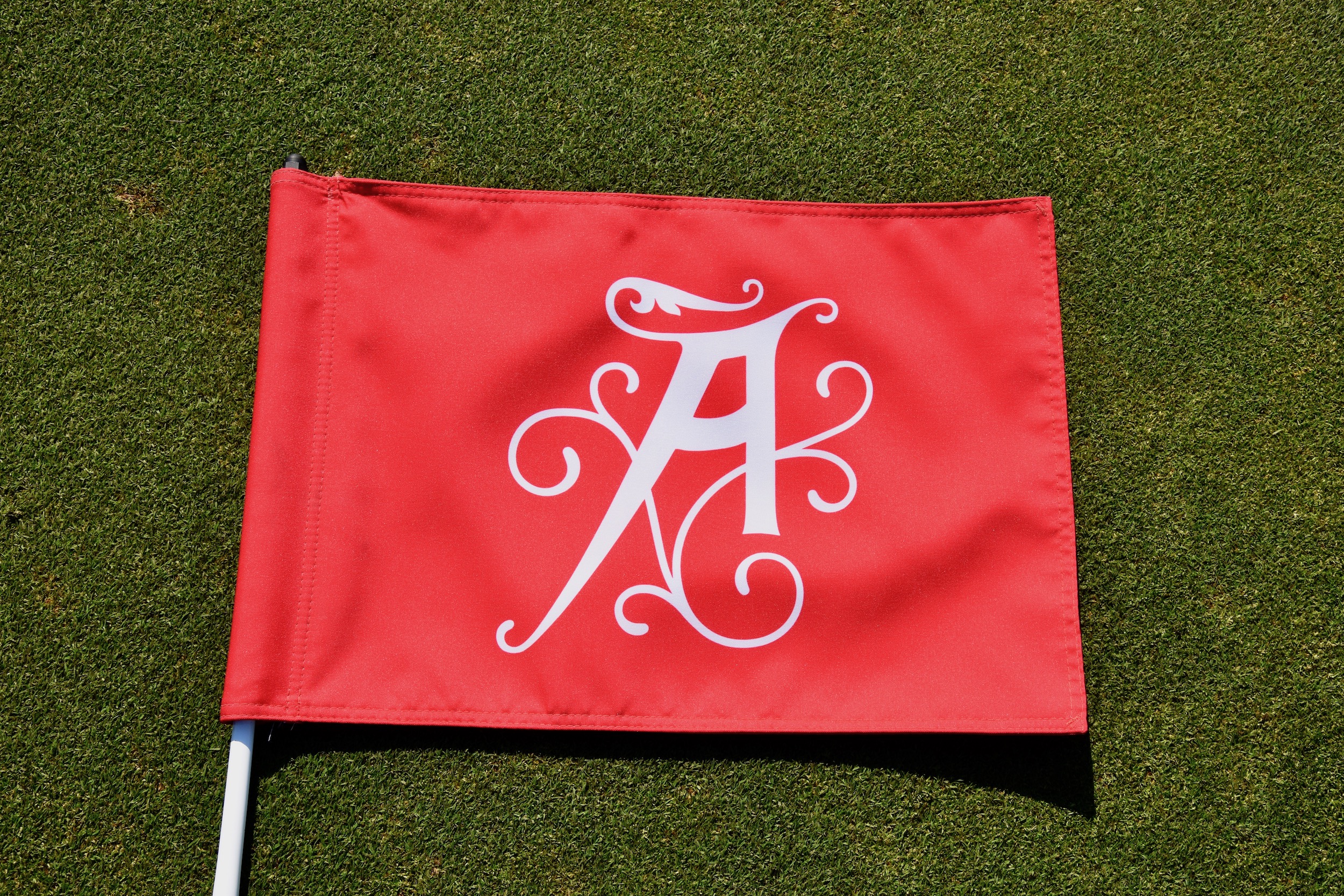
The Algonquin Golf Course, an adjunct to the Algonquin Resort in beautiful St. Andrews-by-the-Sea, New Brunswick is one of the most storied in Canada. It first opened in 1894, making it one of if not the oldest resort course in Canada. However its fame as a great golf course dates from the 1920’s when it was redesigned by the first great American based golf architect, Donald Ross. This was only fitting as Ross was a student of the legendary golfer and architect Old Tom Morris and learned his craft at the home of golf, St. Andrews, Scotland. Bringing his talent to the New World St. Andrews he created a course that withstood the test of time for almost 100 years.
However, with the evolution of golf equipment and increasing lengths of modern golf courses the new owners of the Algonquin Resort who took over from the Fairmont brand in 2012 and reopened as the first Marriott Autograph Collection resort in Canada, realized that the Algonquin Golf Course needed to be modernized. To do that they brought in Canadian golf architect Rod Whitman who was a student of another fabled golf course architect, Pete Dye. Whitman is not a prolific golf course architect like Donald Ross or Pete Dye, but is a meticulous practitioner of his craft. The result is that every one of his Canadian designs ranks in the top 100 in the definitive SCORE Golf rankings. His most highly rated Canadian course is Cabot Links at #5 in the rankings which I described in this hole-by-hole post from last summer.
Whitman realized that the seaside location of Algonquin Golf Course had not been fully utilized and created a series of new holes on the back nine that immediately vaulted the course well up in the SCORE Golf rankings. Every second year the magazine produces a list of the top 59 public courses in Canada and only a few days before playing Algonquin, the list came out with the course ranking #25 beating out such courses as Glen Abbey, Taboo and Silvertip, all of which have higher greens fees than the Algonquin Golf Course. Whitman also lengthened the course to a daunting 7,135 yards with a slope rating of 131 so that it can now challenge even the very best golfers.
With that background in mind let’s go to the course.
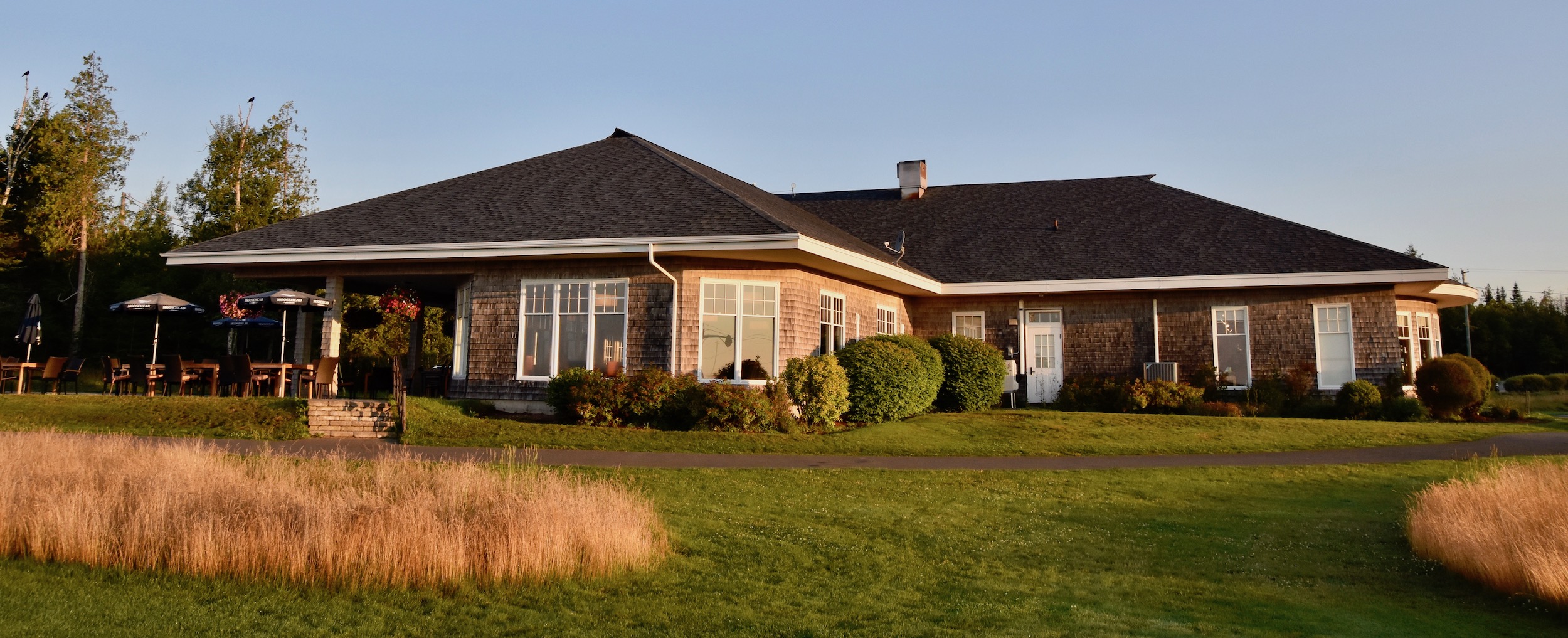
The clubhouse at Algonquin Golf Course is a relatively modest affair, replacing the second club house which in turn replaced what was the oldest clubhouse in Canada that you can still see on the fifteenth hole. It sits at about the highest point of land on the course and from the back patio there are great views of Passamaquoddy Bay. The pro shop is well stocked and we found the staff extremely friendly and helpful. After the round Alison and I both bought pullovers with the distinctive “A” logo of the Algonquin Golf Course.
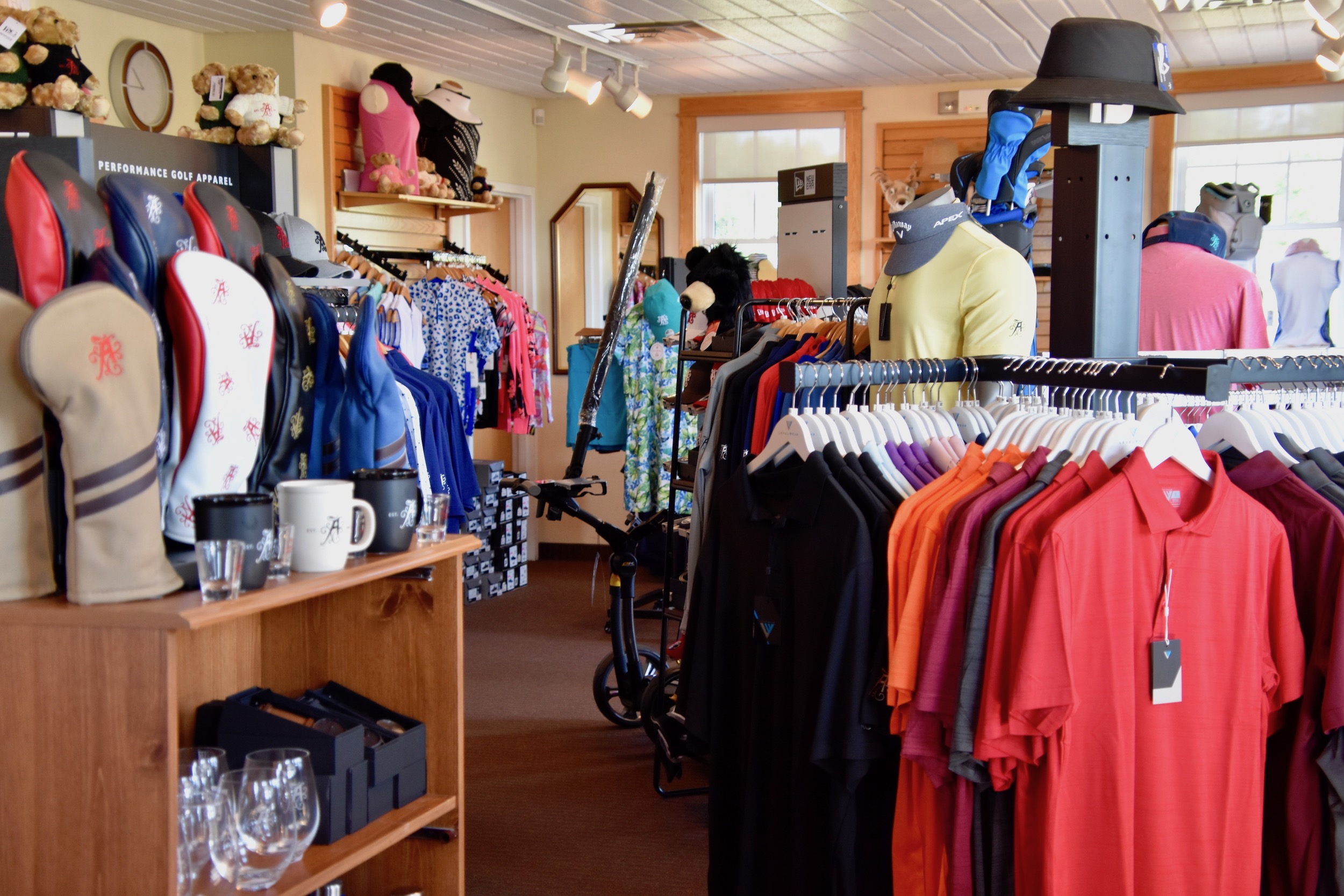
After checking in, we hit a few balls on the driving range on what was turning out to be a beautiful late July morning. That was good news for us as we had tried to play the Algonquin Golf Course on three previous occasions but had been rained out twice and fogged in last summer. This was unusual bad luck because the weather in St. Andrews is generally regarded as the most clement in New Brunswick.
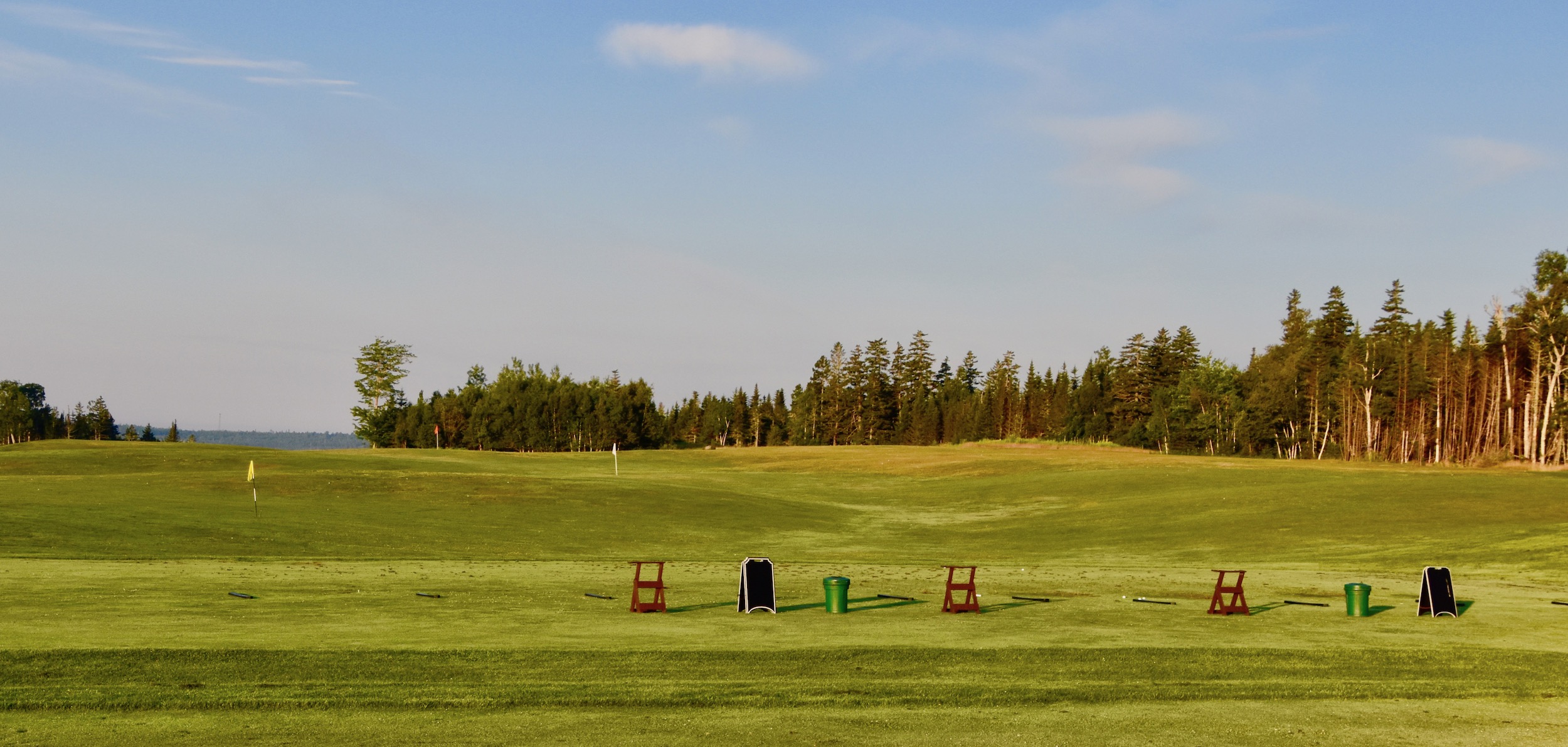
Today I will be playing from the silver tees that measure a decent 6,o36 yards which is about perfect for my age and handicap. Alison will play from the ruby tees which play 5,033 yards which is plenty long for most women golfers. Ok, enough dawdling. Let’s play golf!
Algonquin Golf Course #1 – 320 Yard Par 4
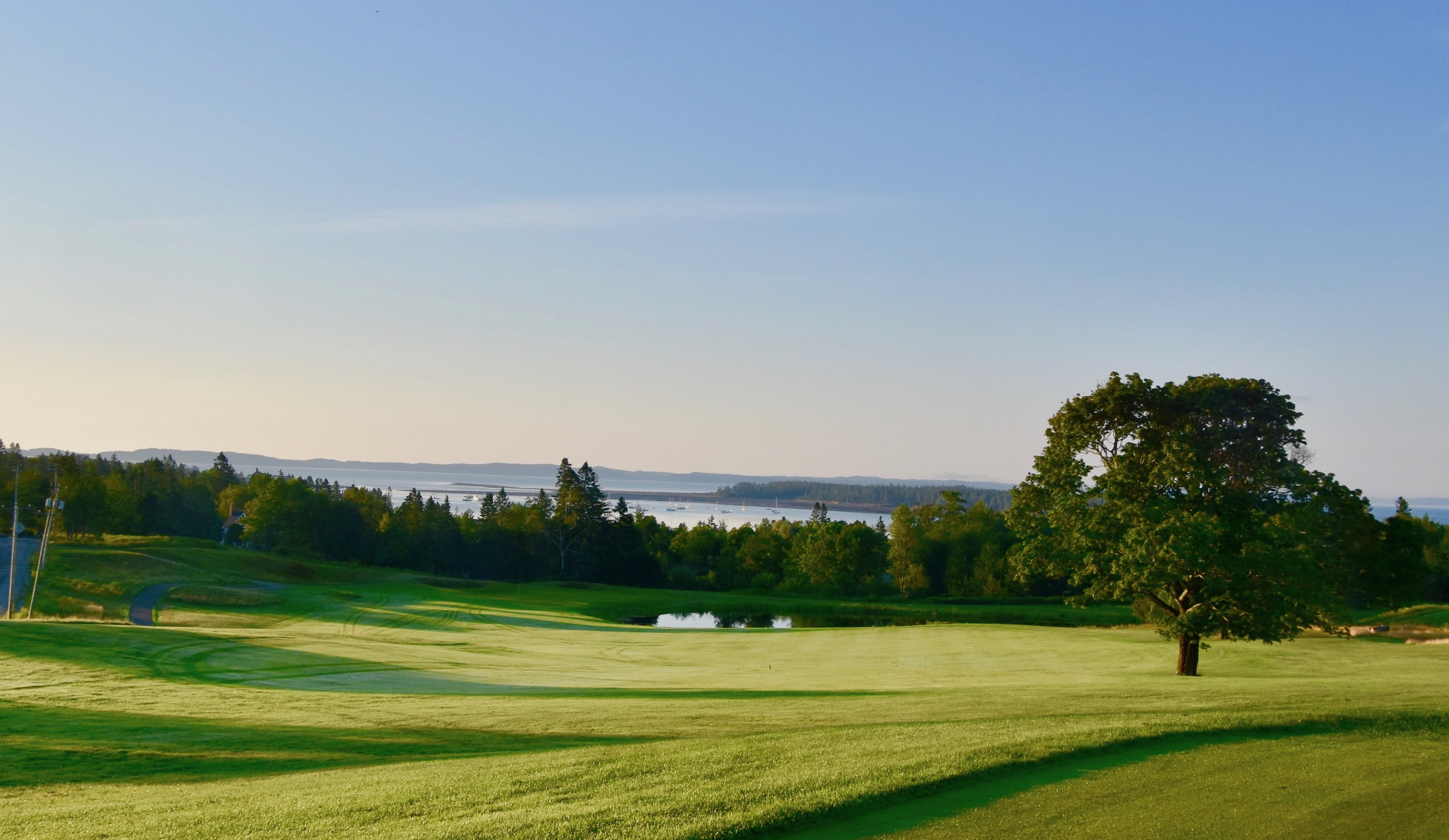
The very first thing you will notice standing on this tee is just what terrific condition the tee boxes and fairway are in. We have a very early tee time so there are still a few shadows obscuring the hole, but I can say that I loved this starting hole. It has a beautiful look with the mature specimen tree to the right and the pond straight down the hill with the green to the left. The hole has a natural flow to it that you seldom see on many starting holes. Any decent drive should leave just a wedge or short iron into the relatively modest green.
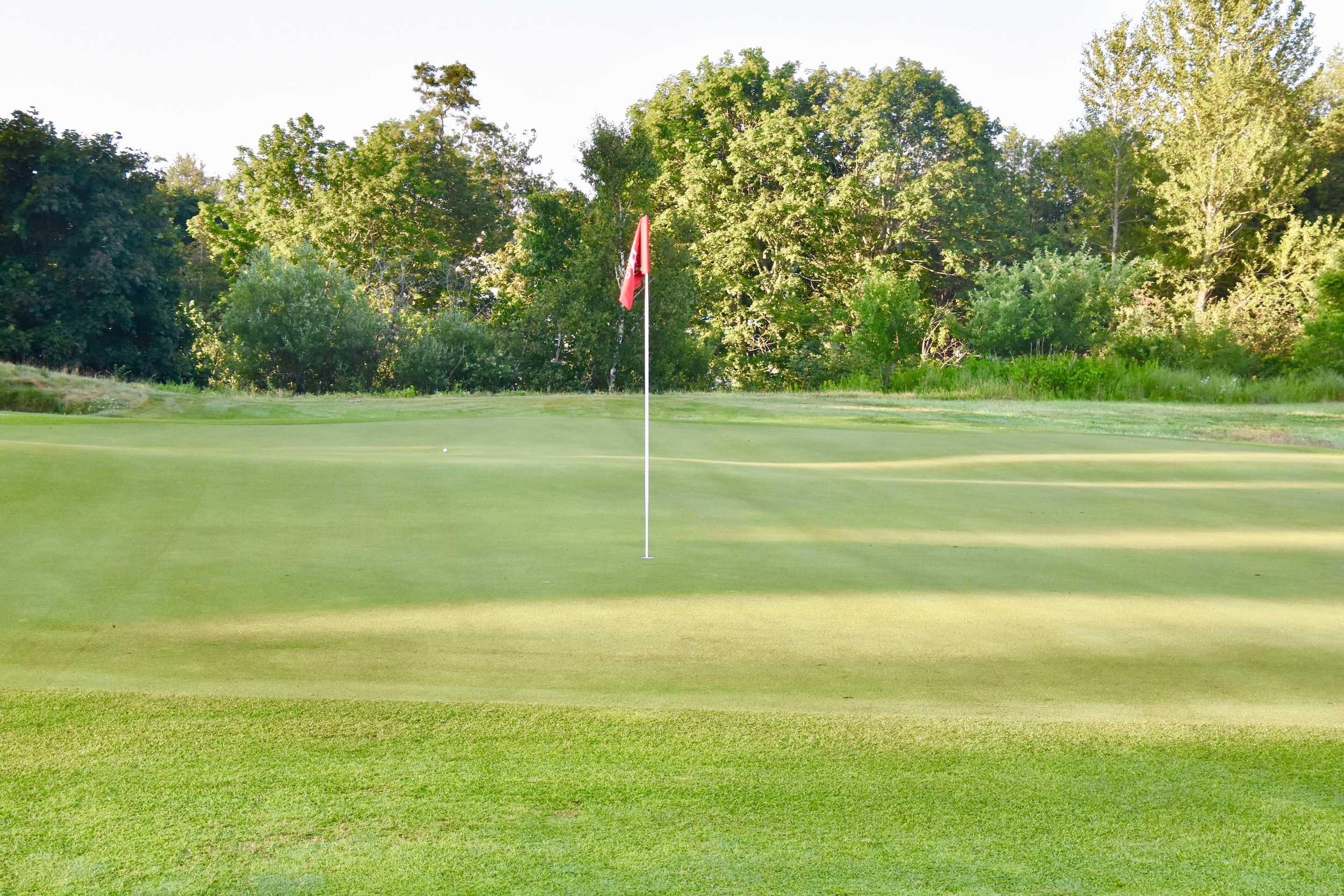
As you can see this green and all the others on the course are in tip top condition. There was still a bit of dew on the ground so the greens did not run as fast as they would after things dried out. Later in the round they really quickened up a lot. I found the greens at Algonquin Golf Course a bit tricky to read with the undulations being more subtle than apparent. I confess to having completely misread the break on at least three of them. However, the greens are in no way unfair or unnecessarily tricked up. They are basically what you would expect from a top notch resort course – challenging, but not to the point of snapping your putter over your knee.
Overall, I was surprised that this starting hole is rated #7 on the handicap scale. Unless you find the water here and there really is no reason to, this should be a par or bogey at worst.
#2 – 360 Yard Par Four
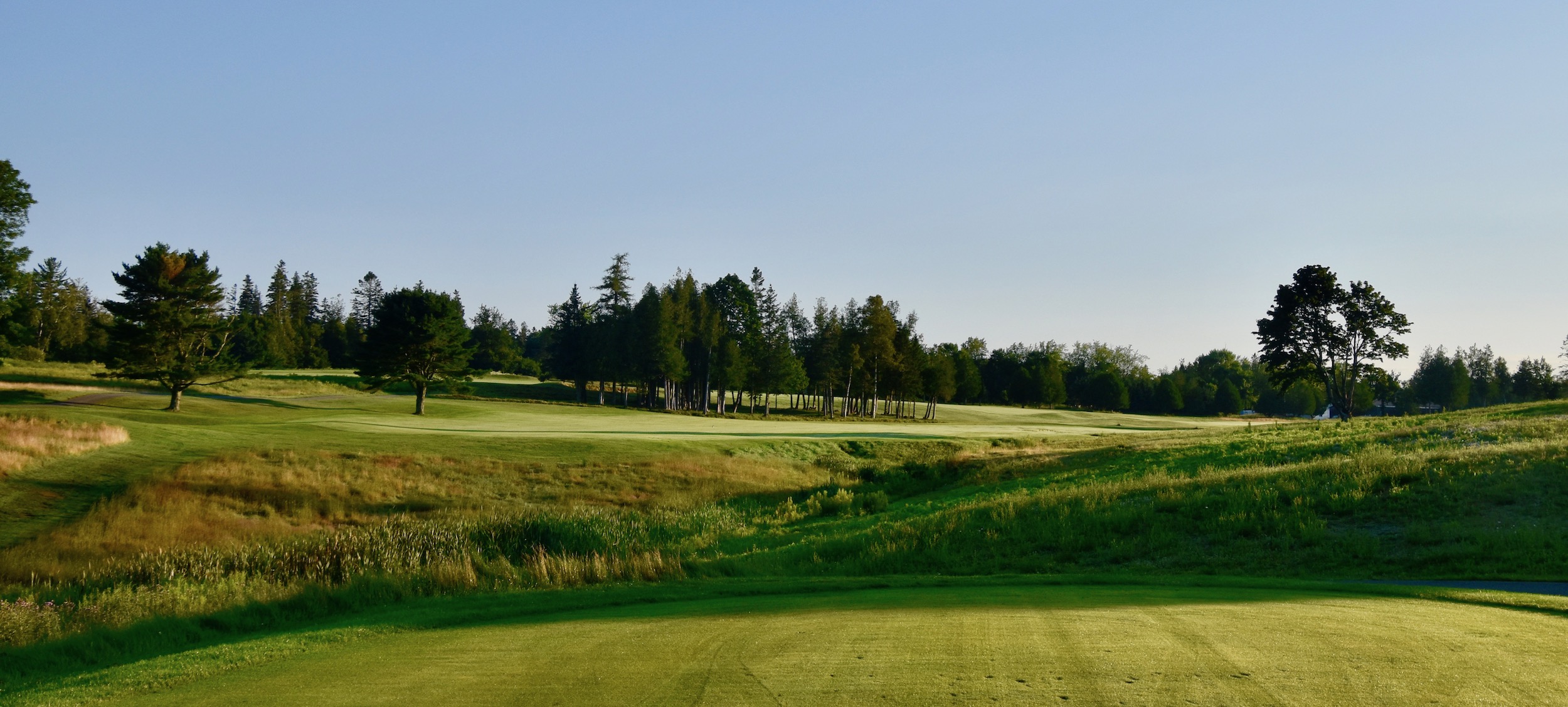
If I found the first hole very playable, I soon got my comeuppance on the second hole which requires a pretty decent carry off the men’s tees and then a very precise second shot. This is a great risk/reward hole. Just how much are you going to try to cut off with your drive? For me the answer was not much, because if you fail to reach the fairway expect nothing but disaster. The rough is thick and you can easily lose a ball in it. What’s worse is that your second shot becomes extremely difficult as we shall see.
This is as good a hole as any to show the pristine conditioning of the tee boxes which is a temporary distraction from having to hit my drive here.
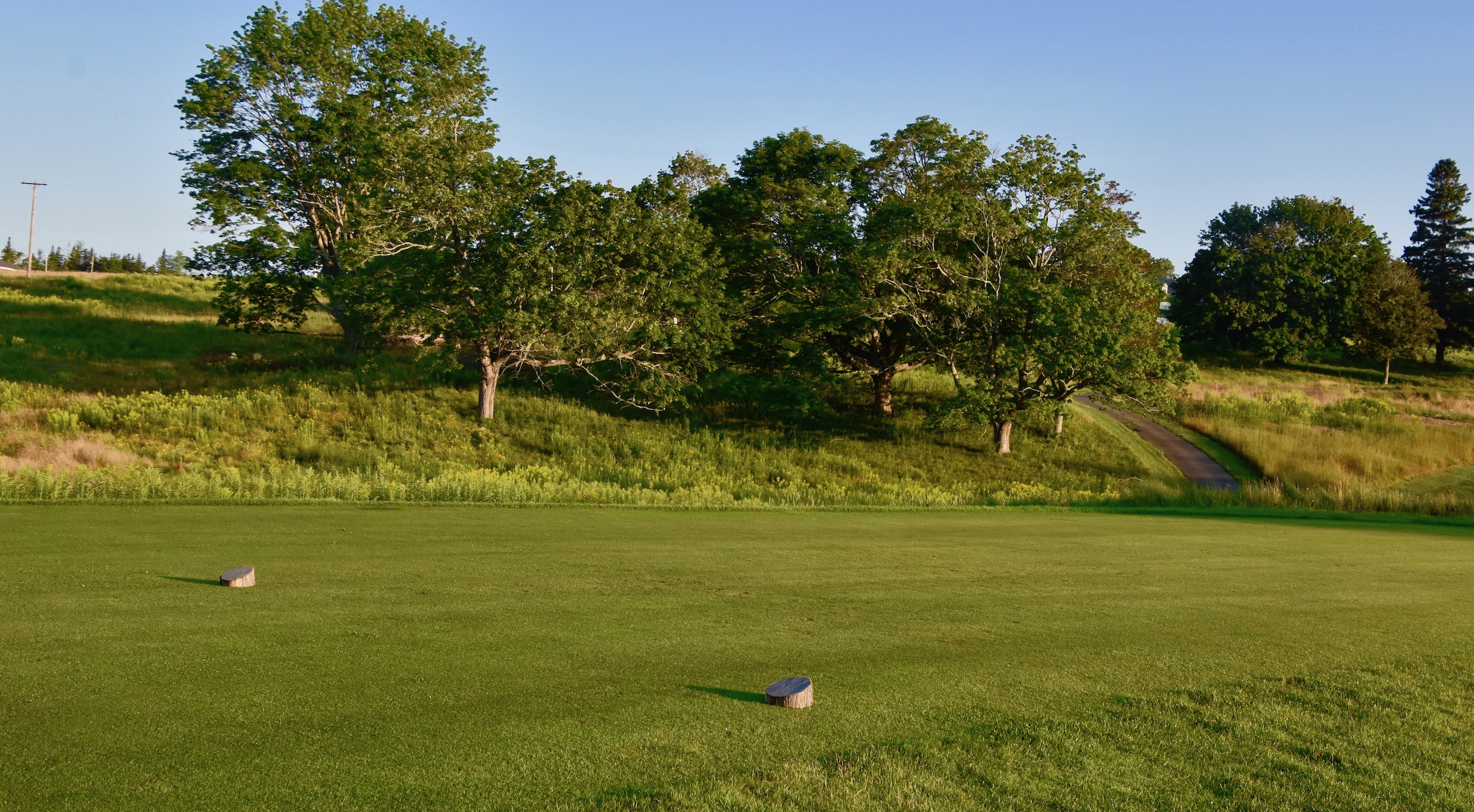
From the ruby tees, which I expect many seniors might play, it is a completely different hole and much more straightforward.
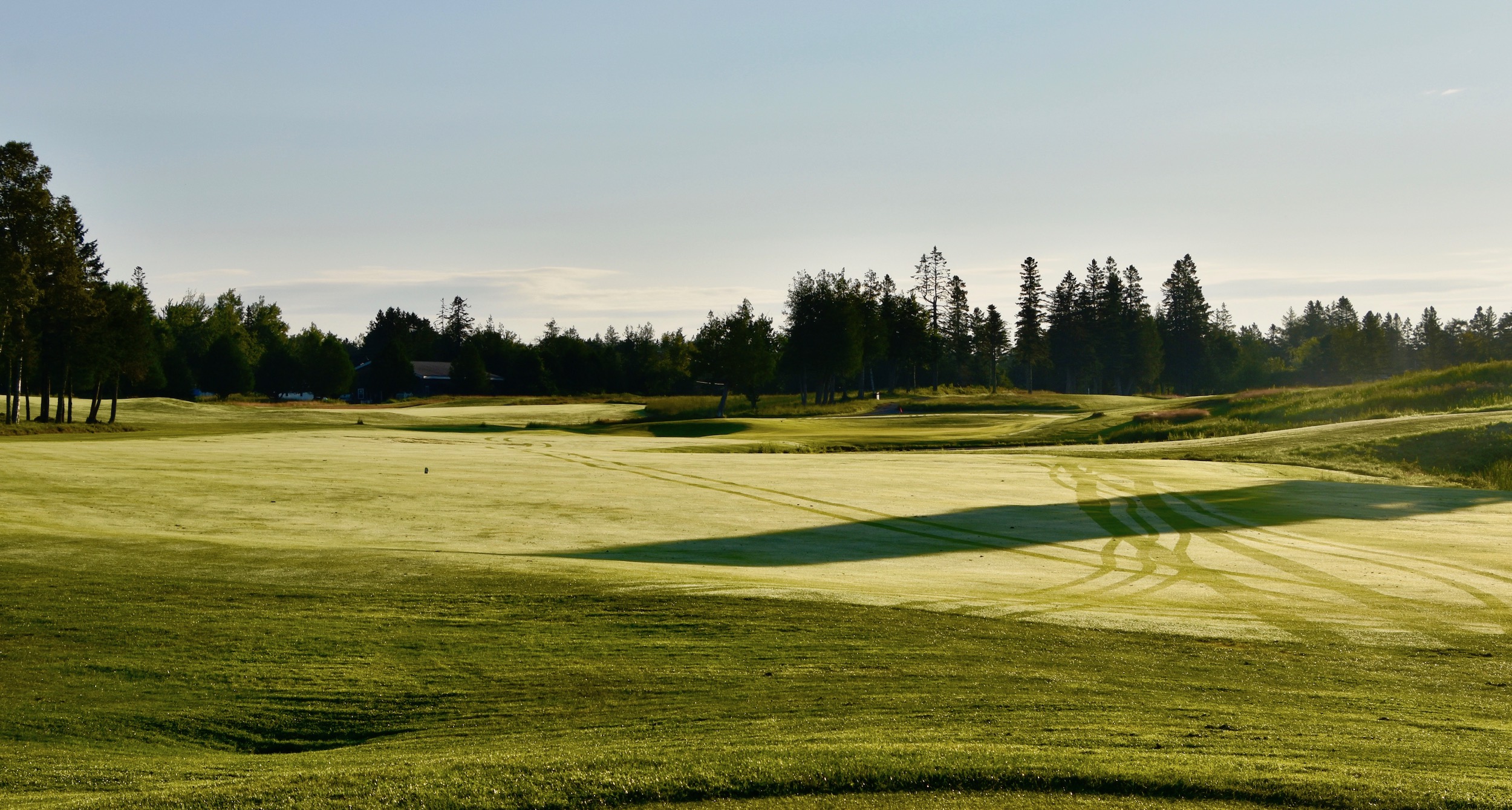
Assuming you do make the fairway from the men’s tees you still have this daunting second shot. Unlike #1, the water is definitely in play here and there’s no way to avoid crossing it. Maybe I’m a wimp, but I found this to be the hardest hole on the front nine and yet it’s only #15 on the handicap scale.
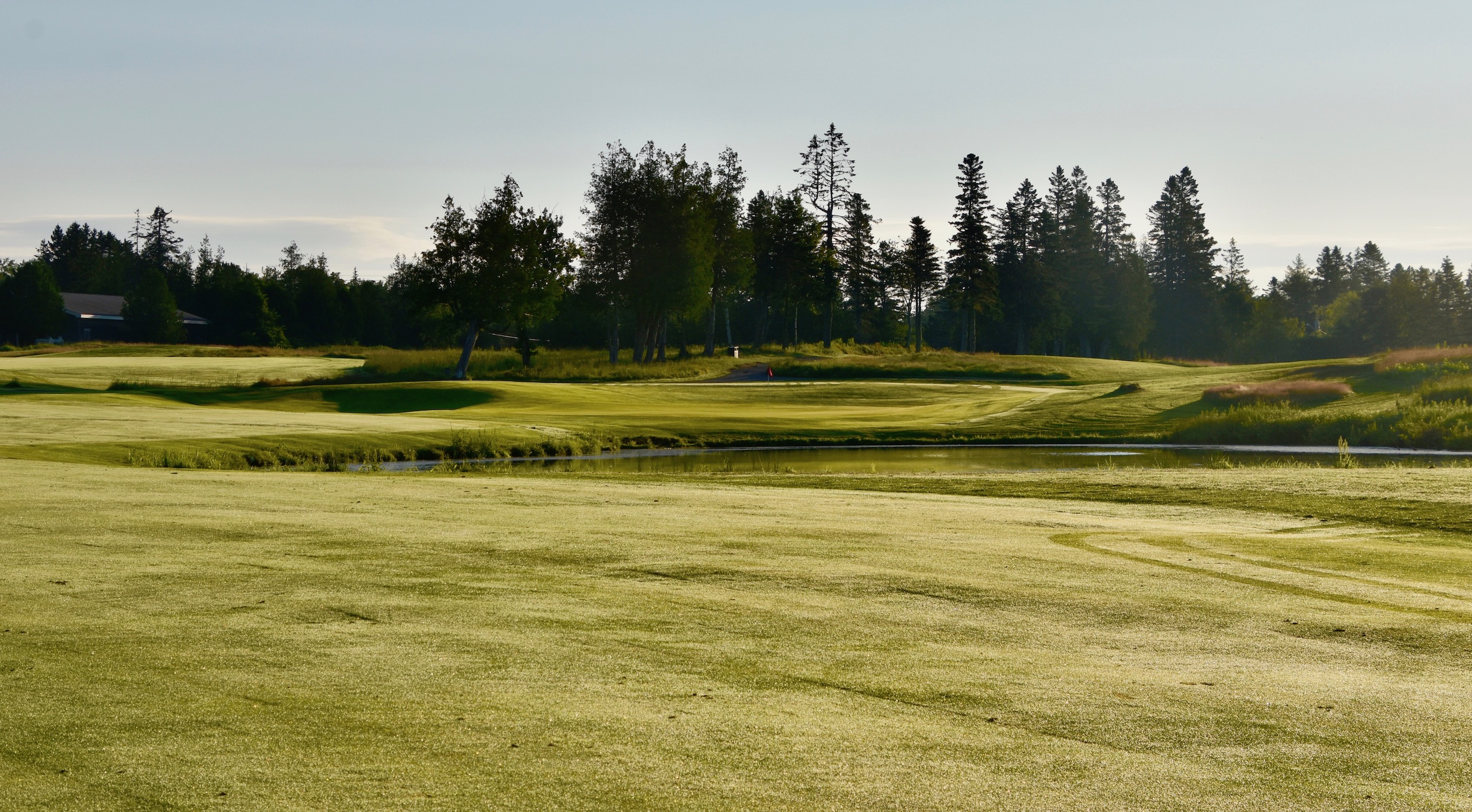
Here’s a shot looking back which gives a better view of just how much water you must carry to reach the green. Despite its difficulty, I think that this is a great golf hole and combined with #1 makes for one of the best starting hole combinations in Atlantic Canada.
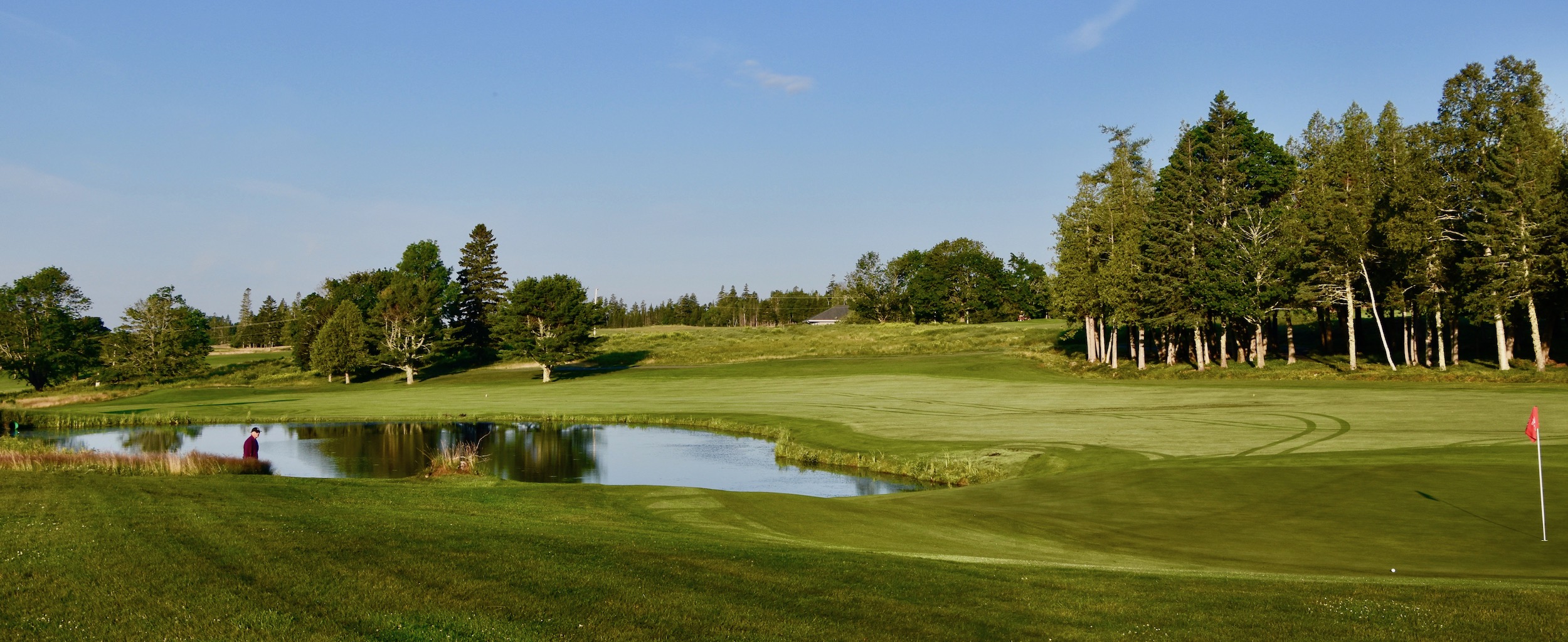
Algonquin Golf Course #3 – 134 Yard Par Three
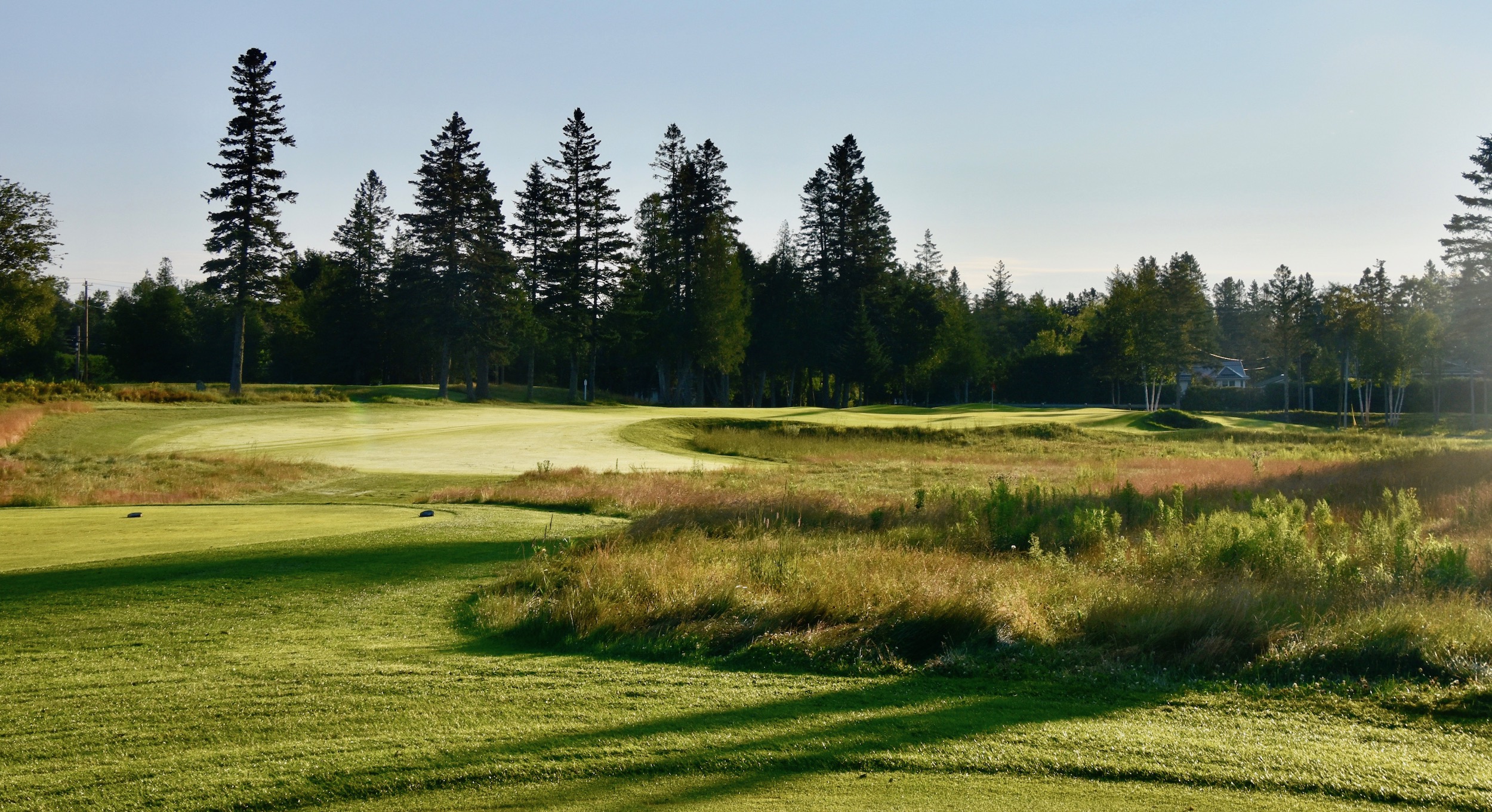
The first of the five par threes at Algonquin Golf Course is among the easier holes in the layout, mainly because of its short length and relative flatness. With no wind this morning it’s really just a matter of hitting the right club for the distance.
#4 – 395 Yard Par Four
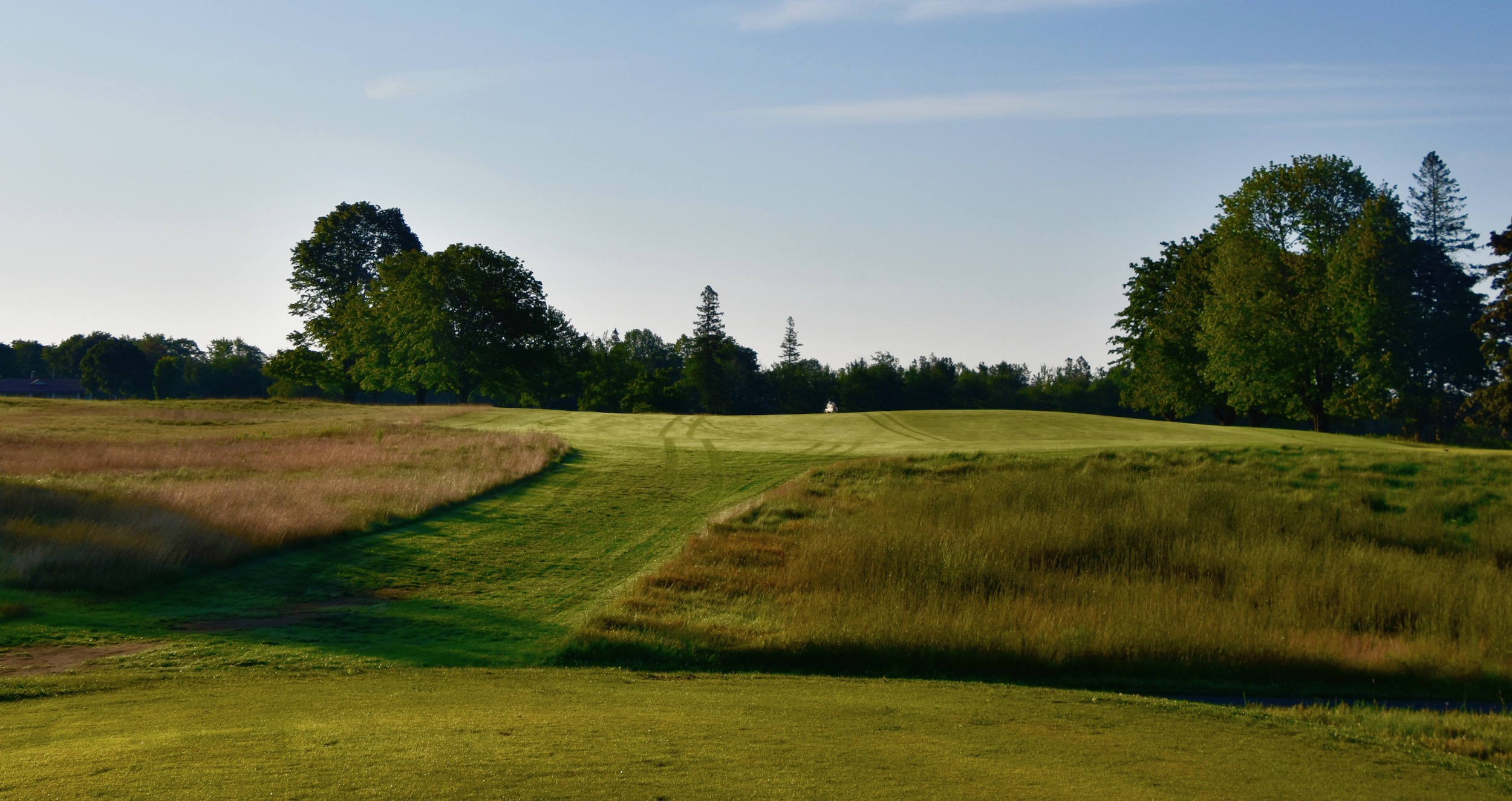
This is the #1 handicap hole at Algonquin Golf Course and features a blind tee shot, something I’ve never been a fan of. However, there is a reasonably generous landing area which sets up something like this for your second shot. If you truly should be playing from the silver tees then you will have a very long way in, requiring a wood or hybrid.
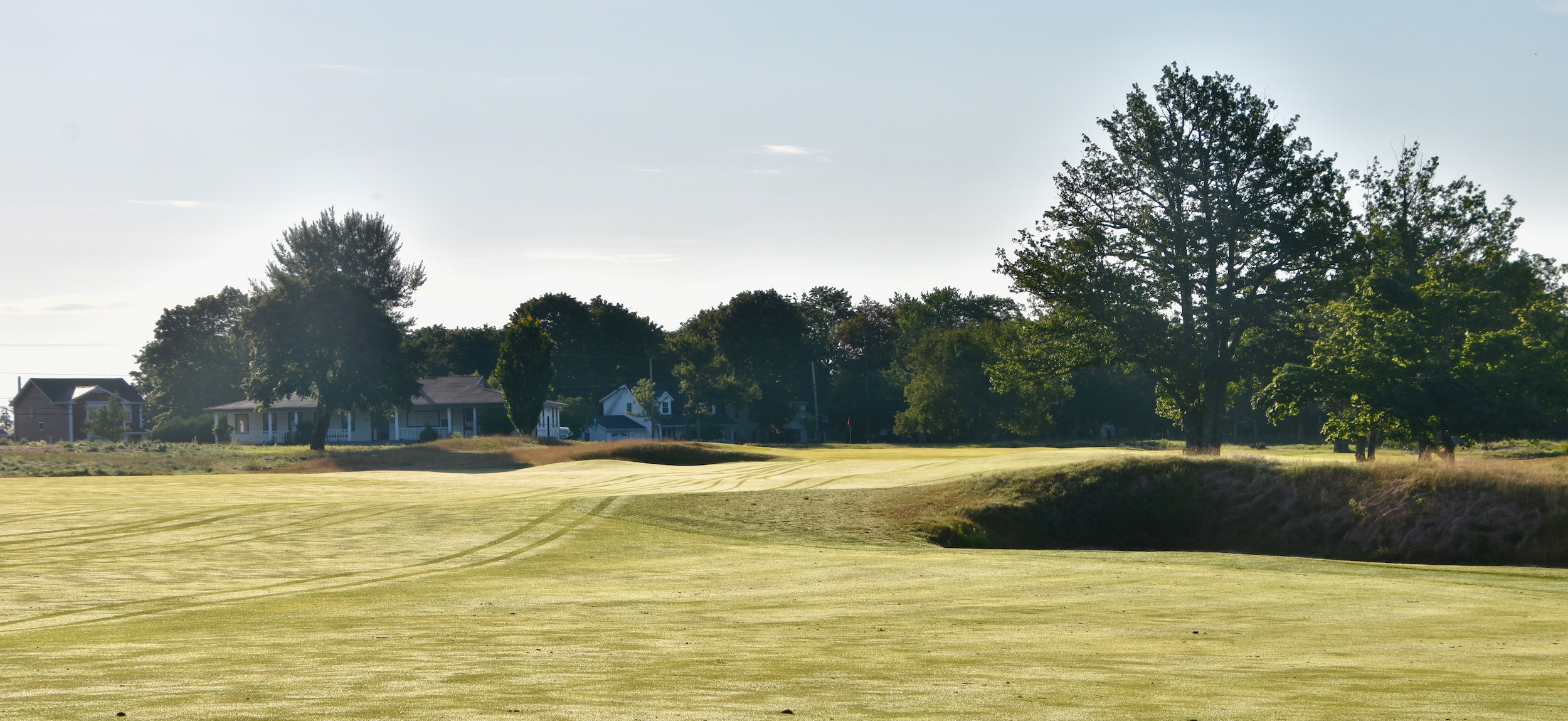
Here is the fourth green which is crowned and that of course makes staying on it well nigh impossible if you forced to hit a wood or hybrid into it. This is indeed very difficult par four and bogey is a very acceptable score, especially if you are not a long hitter.
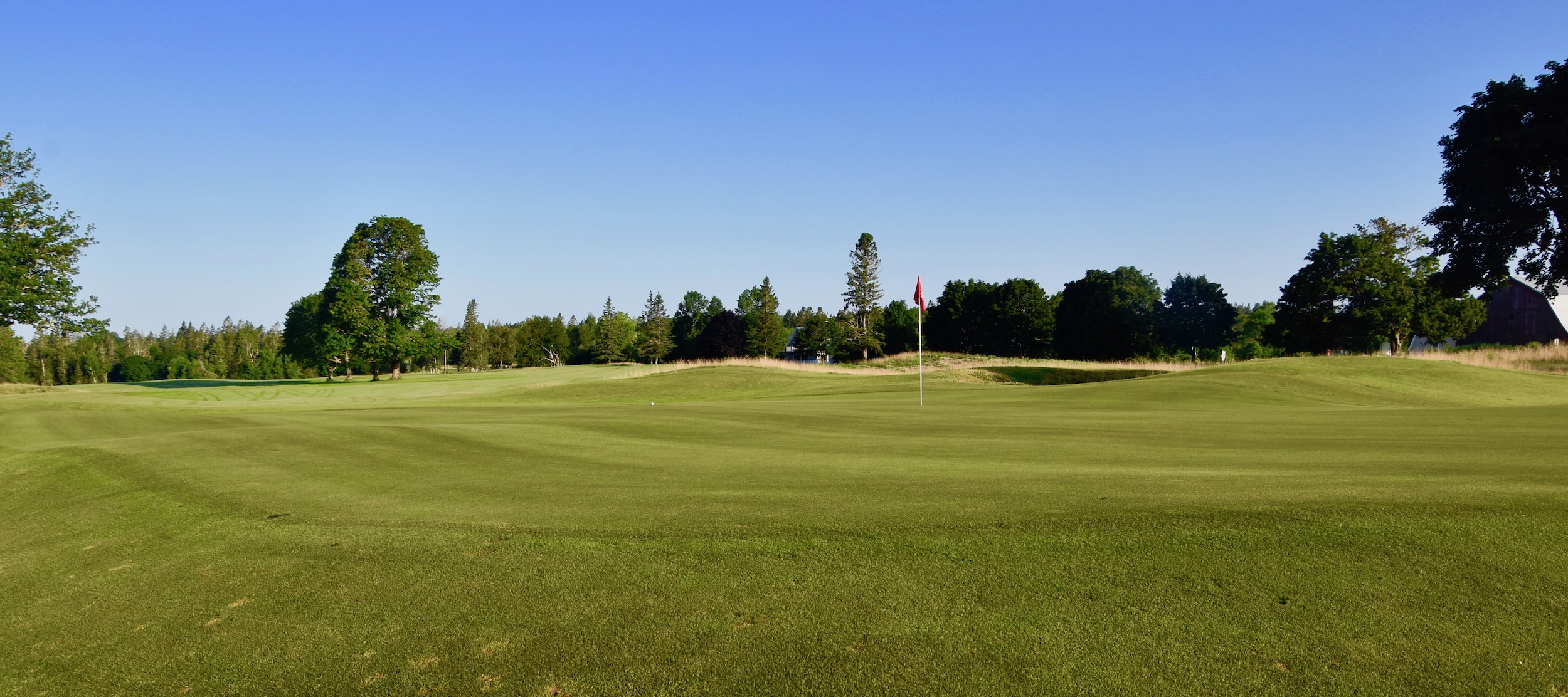
Algonquin Golf Course # 5 – 498 Yard Par Five

The first par five at Algonquin Golf Course is a good one that if I had to give it a name, would be ‘The Squeeze’. From the tee box there is a ridiculously wide fairway with no reas0n to go anywhere the trap on the right unless you plan on cutting off a slice of the dogleg. My plan was to play it safe, which doesn’t lead to many birdies, but should avoid anything worse than a six.
Here is the second by Alison who hit a very good drive from the ruby tees. You can see that the fairway narrows considerably.
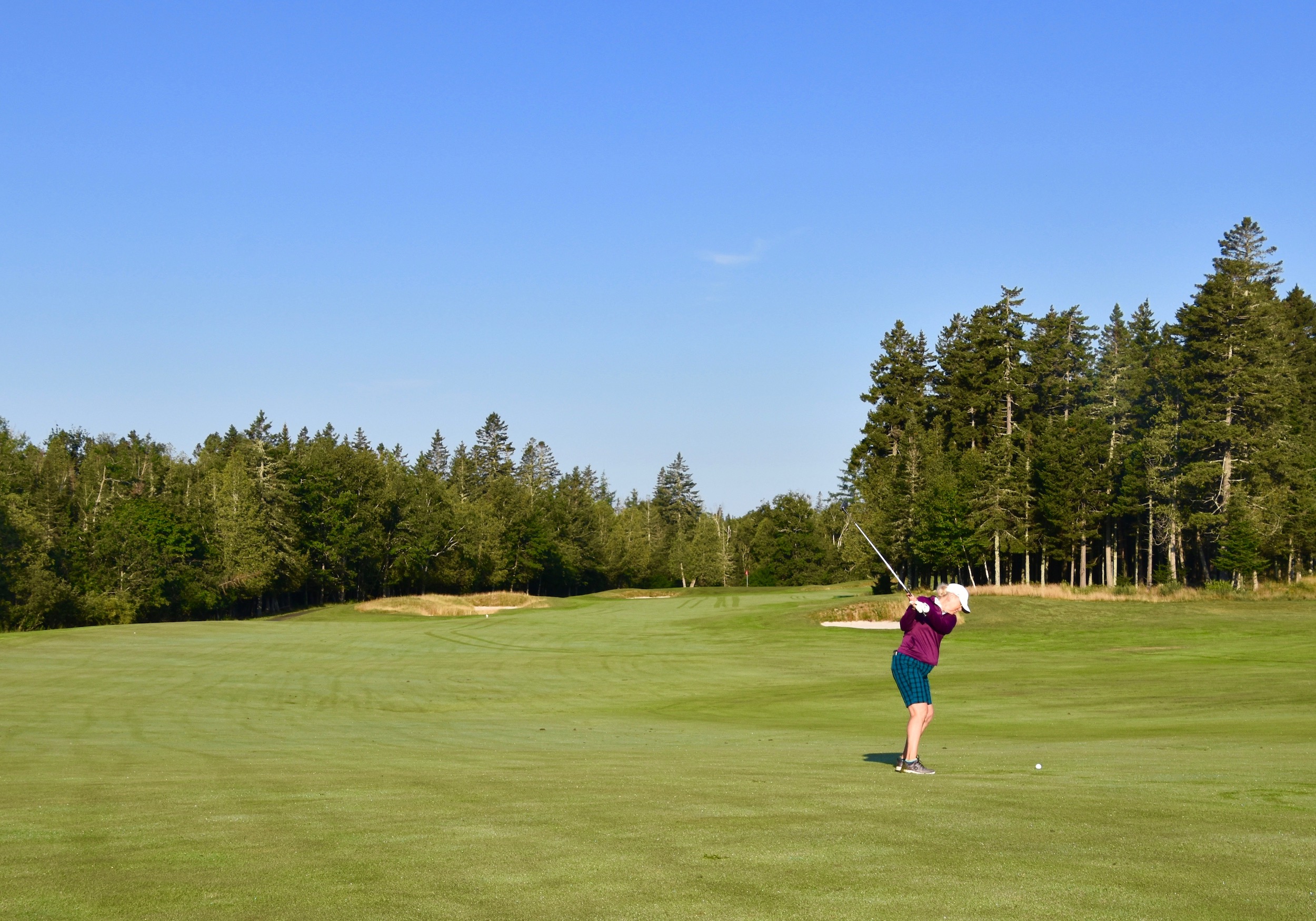
And here is the approach shot to a small well guarded green that leaves no room for error. I really liked the way this hole made each of the three shots required to reach the green progressively more difficult in effect, putting the squeeze on you.
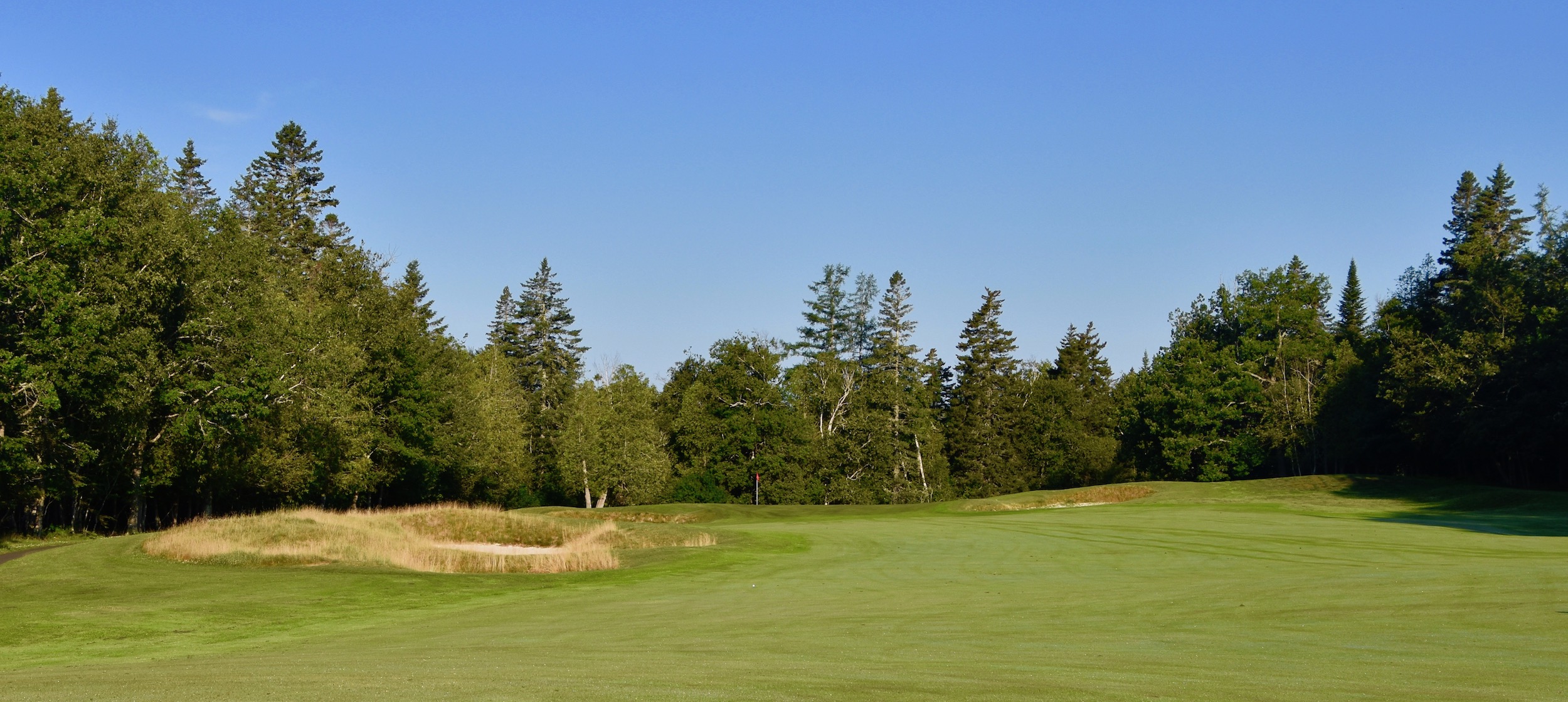
#6 – 357 Yard Par Four
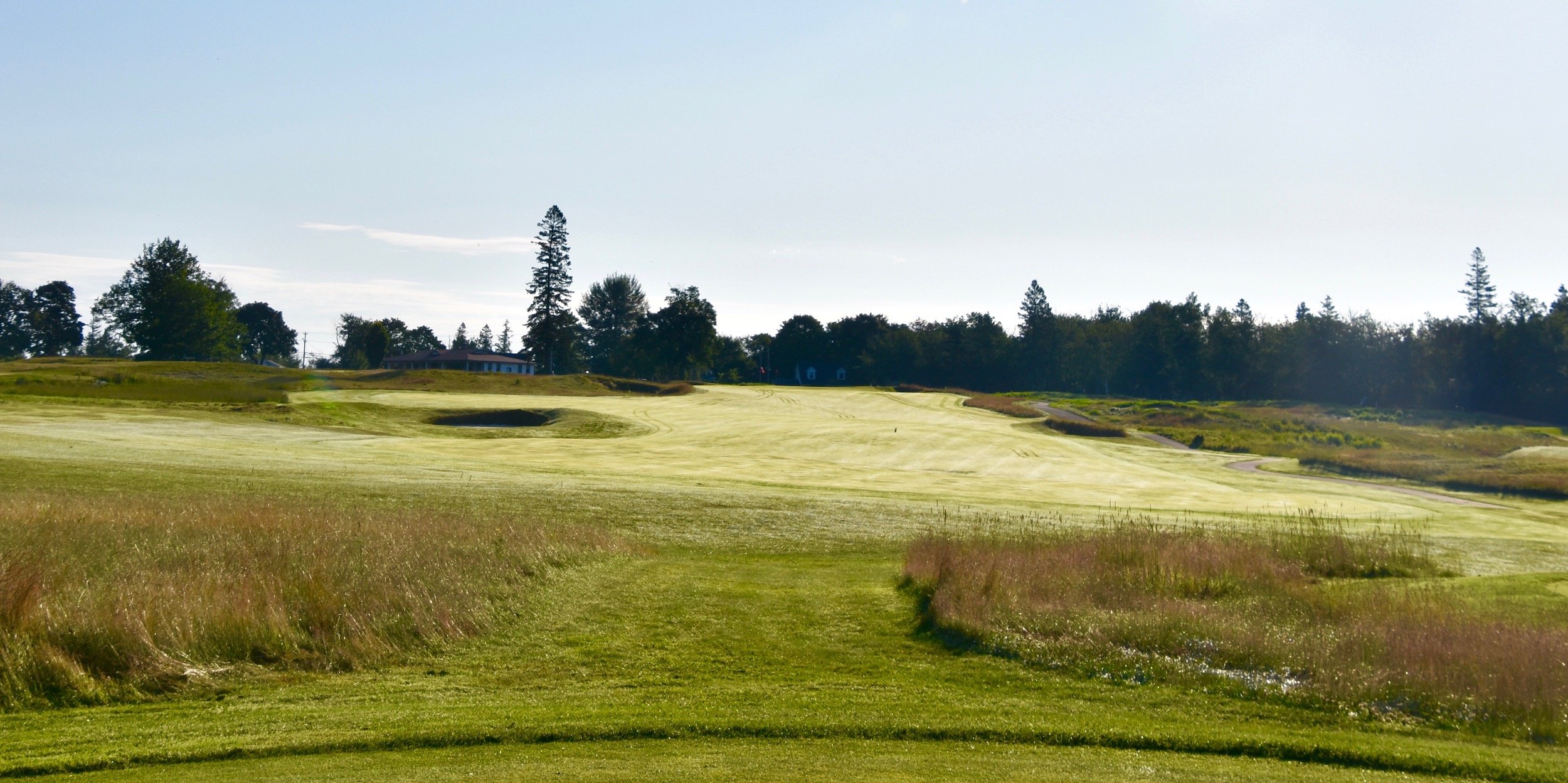
The tightness of the drive on this hole makes it the #3 handicap hole and deservedly so. Anything right is in big trouble, but there is some room to the left over the trap. Not my favourite hole on the course, but one I respected by putting away the driver and using a three wood off the tee. Wish I could say it worked.
Algonquin Golf Course #7 – 368 Yard Par Four
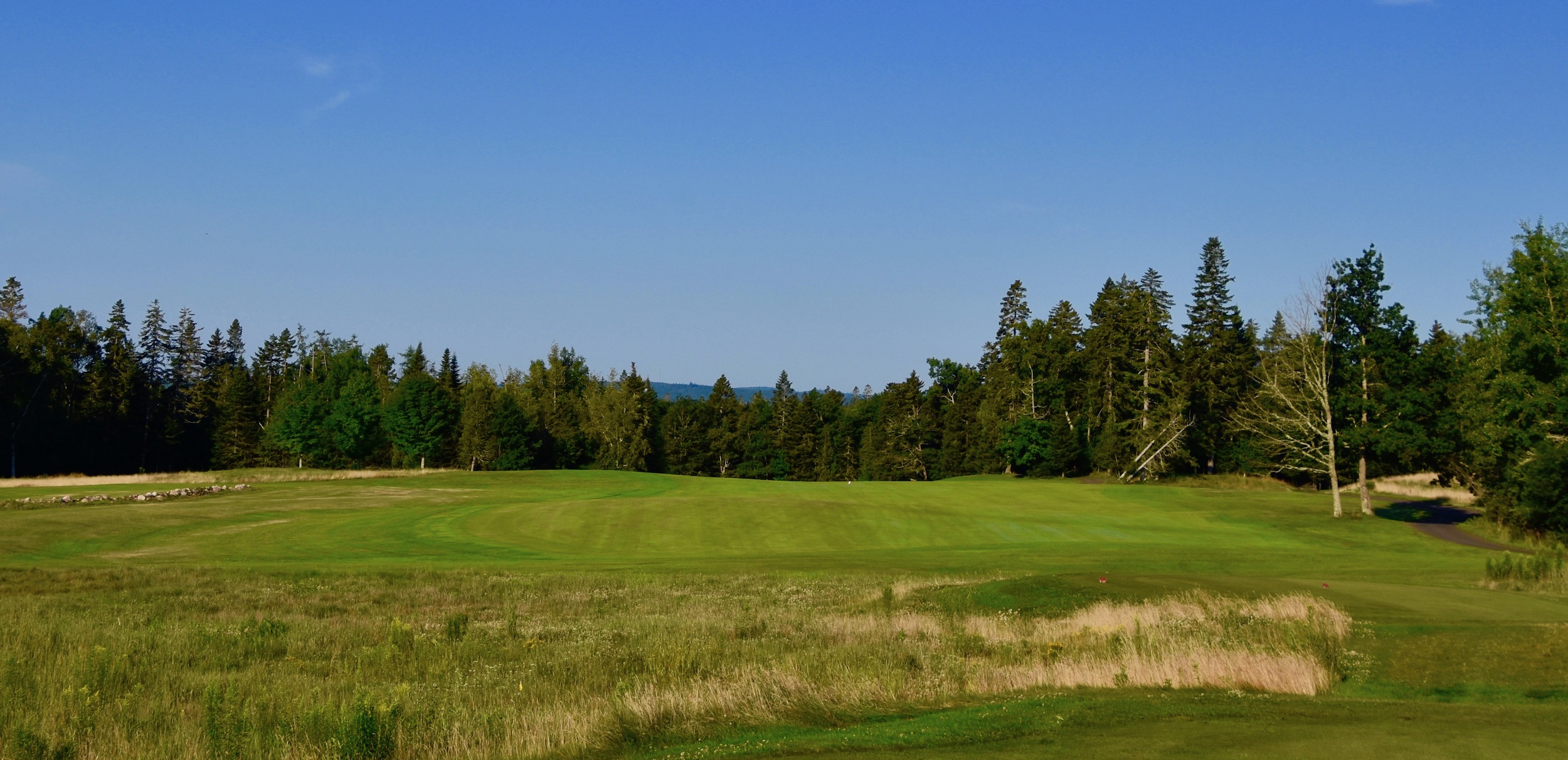
While I noted earlier that I’m not a big fan of blind tee shots, I really don’t mind those where the hole is falling away and you can imagine your ball getting extra distance if you can reach the edge of the downslope. Luckily I did and that makes the hole play much shorter than its professed length.
Here is the second shot into #7. With the drop in elevation and the somewhat bowled green you can go flag hunting here.
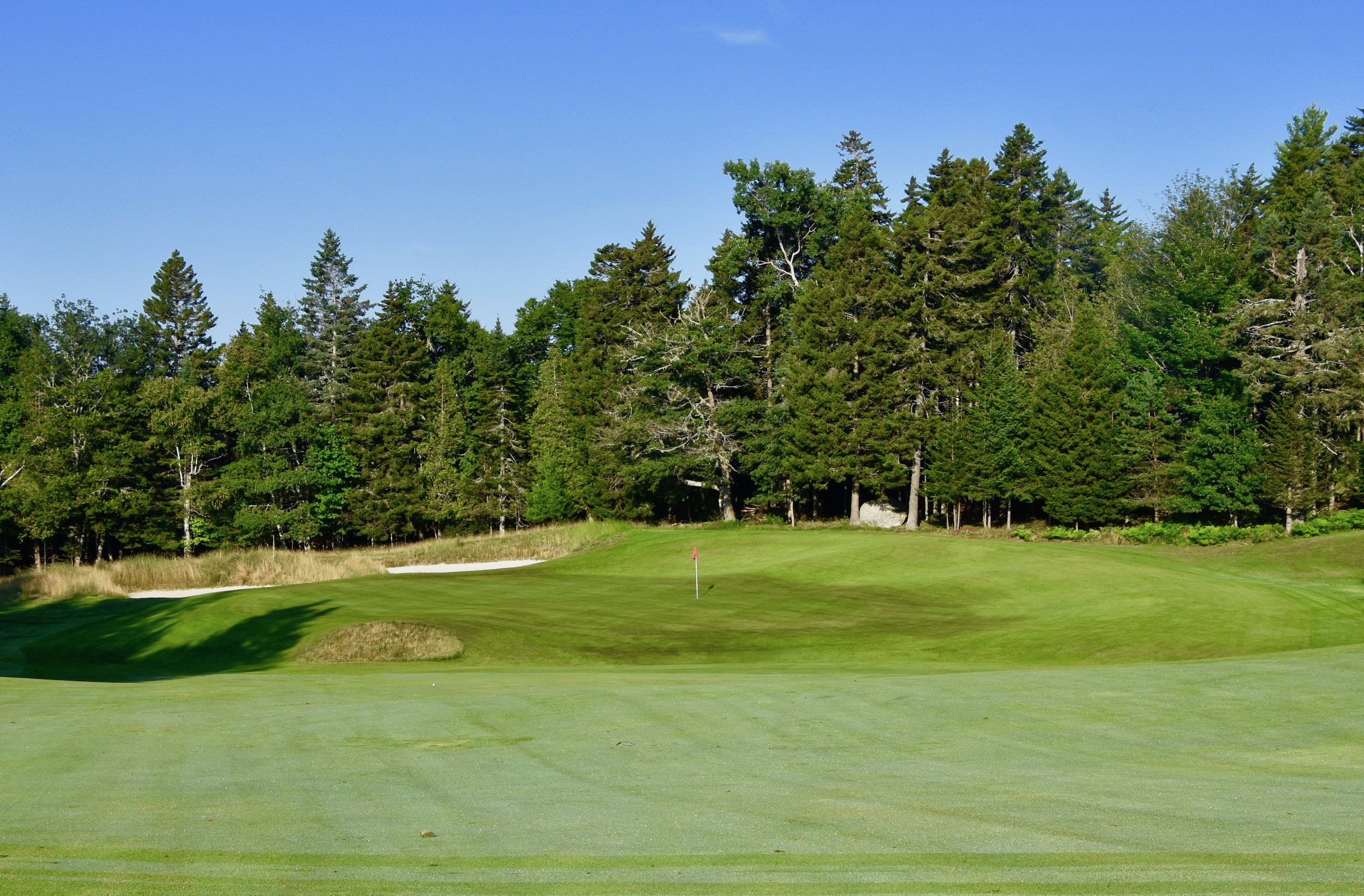
#8 – 160 Yard Par Three
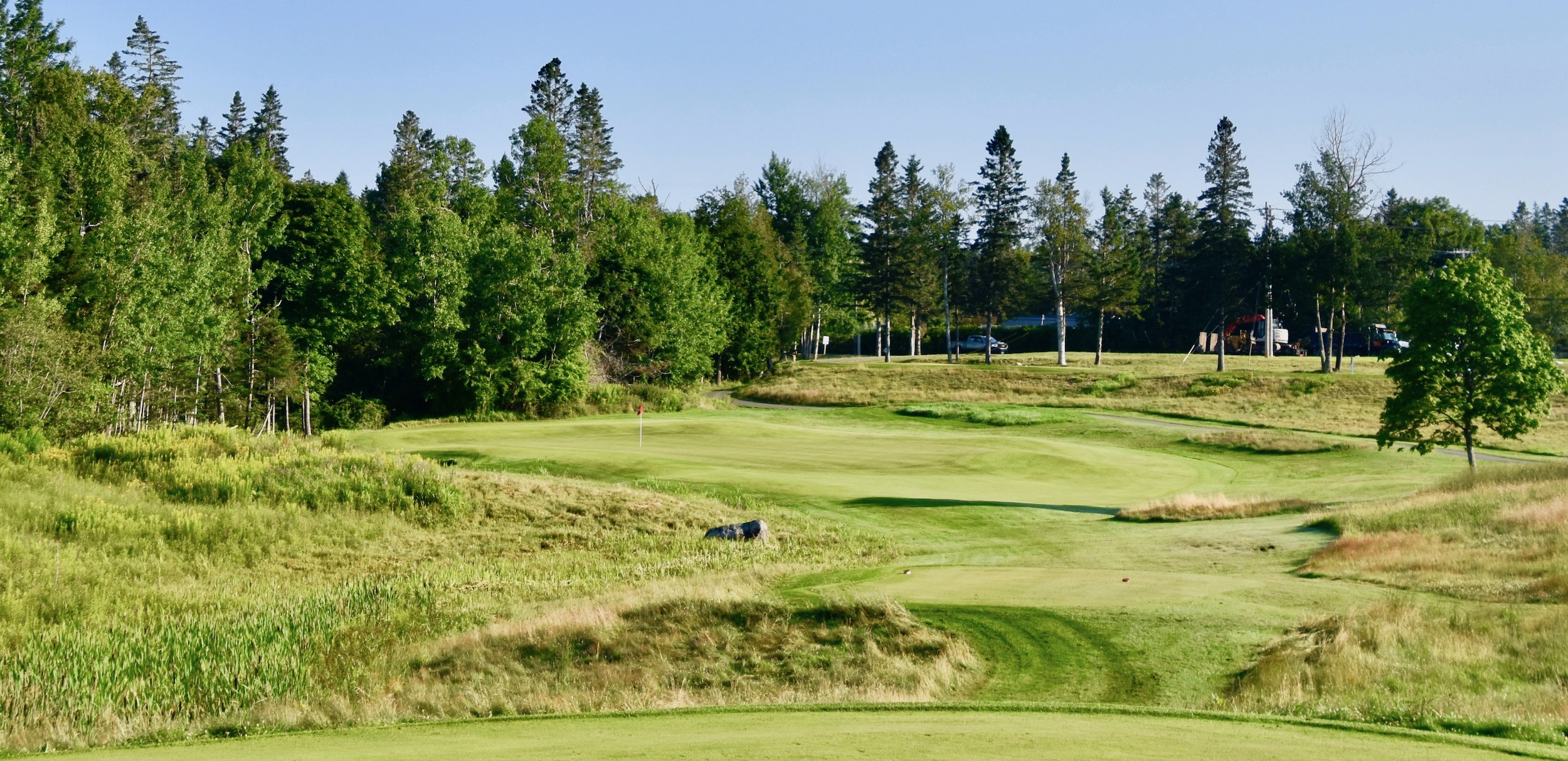
This is a much better par three than #3. The green is pretty generous, but you must carry it all the way there to avoid trouble. The rough on the left actually turns into a bit of a marsh so if you are going to miss, do it to the right. One of the trickier greens on the front nine, especially if you are above the hole. Par is a good score here.
Algonquin Golf Course #9 – 465 Yard Par Five
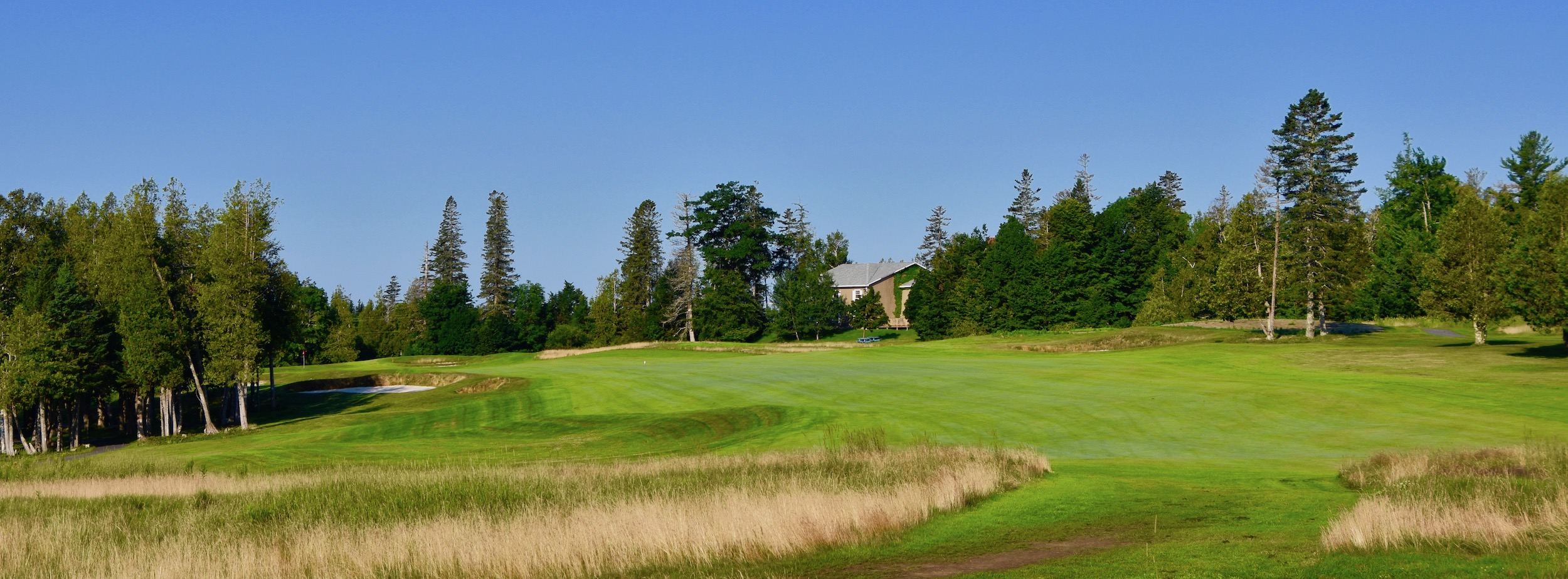
This is by far the easiest hole on the front nine and probably the best birdie opportunity on the Algonquin Golf Course. It’s perfect for a right to left ball flight and a good drive should bring an opportunity to get very close to the green in two. I played it a bit too safe and had this shot for my approach. Still it was an easy wedge and two putt for par, a nice way to finish the front nine, although a birdie would have been better.
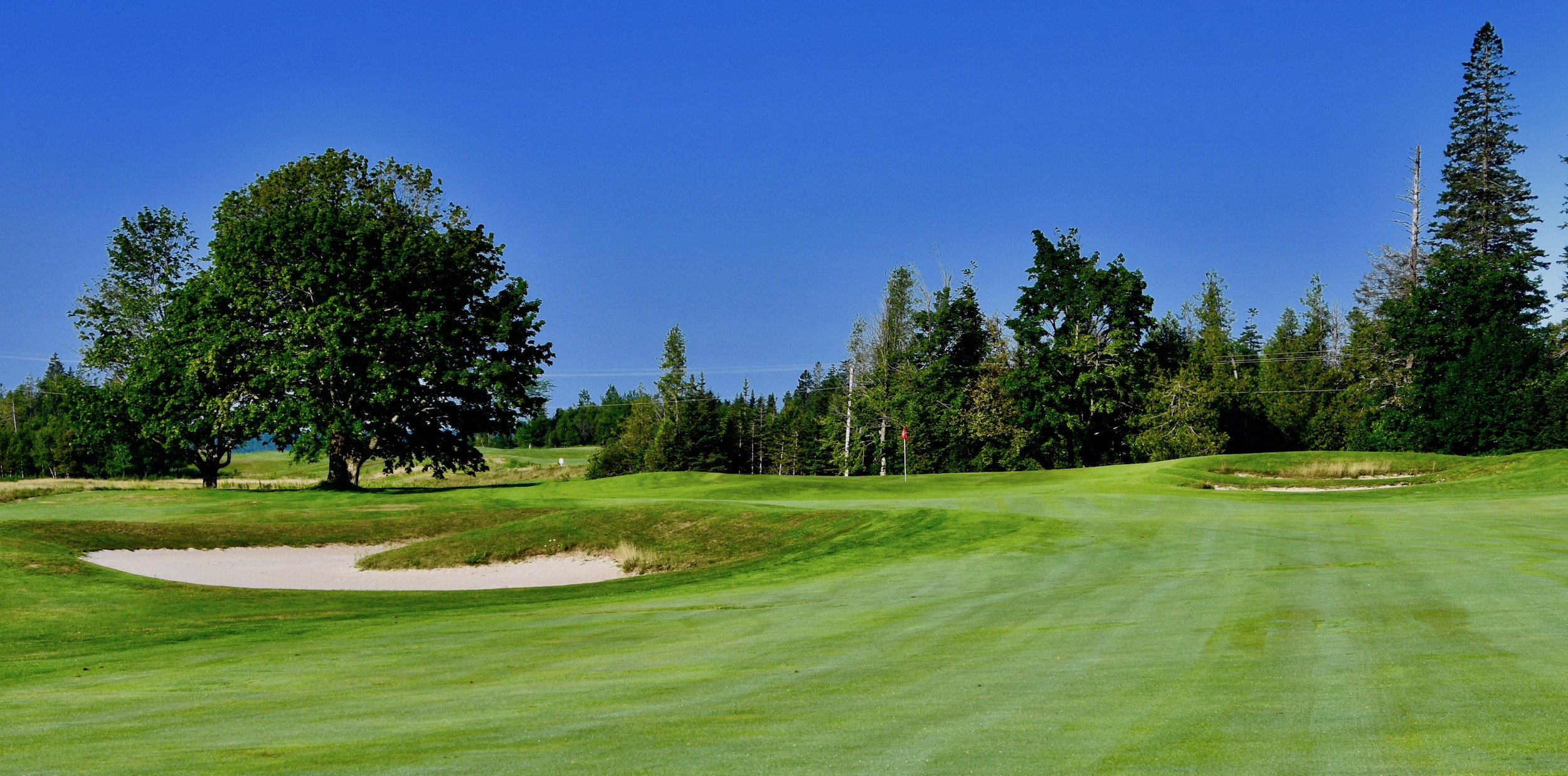
In preparing to play a course I always read the accolades about the course on the website to see if they seem legitimate or not. In the case of the Algonquin Golf Course, the raves come from Jason Logan who is the guy who runs the SCORE Golf course evaluation system and Robert Thompson who I know from being a member of the Golf Journalists Association of Canada. They both consider the first four holes on the back nine among the best stretches of golf in the country. Having played the back nine, my question is “Why only four holes?” While the front nine is a great example of a parkland golf course, the back nine is only rivalled in Atlantic Canada by the two Cabot courses and Highlands Links in terms of scenery, playability and overall golf experience. I guess you’ve figured out that I agree with Josh and Robert that this is a bucket list golf experience. So let’s play the back.
#10 – 202 Yard Par Three
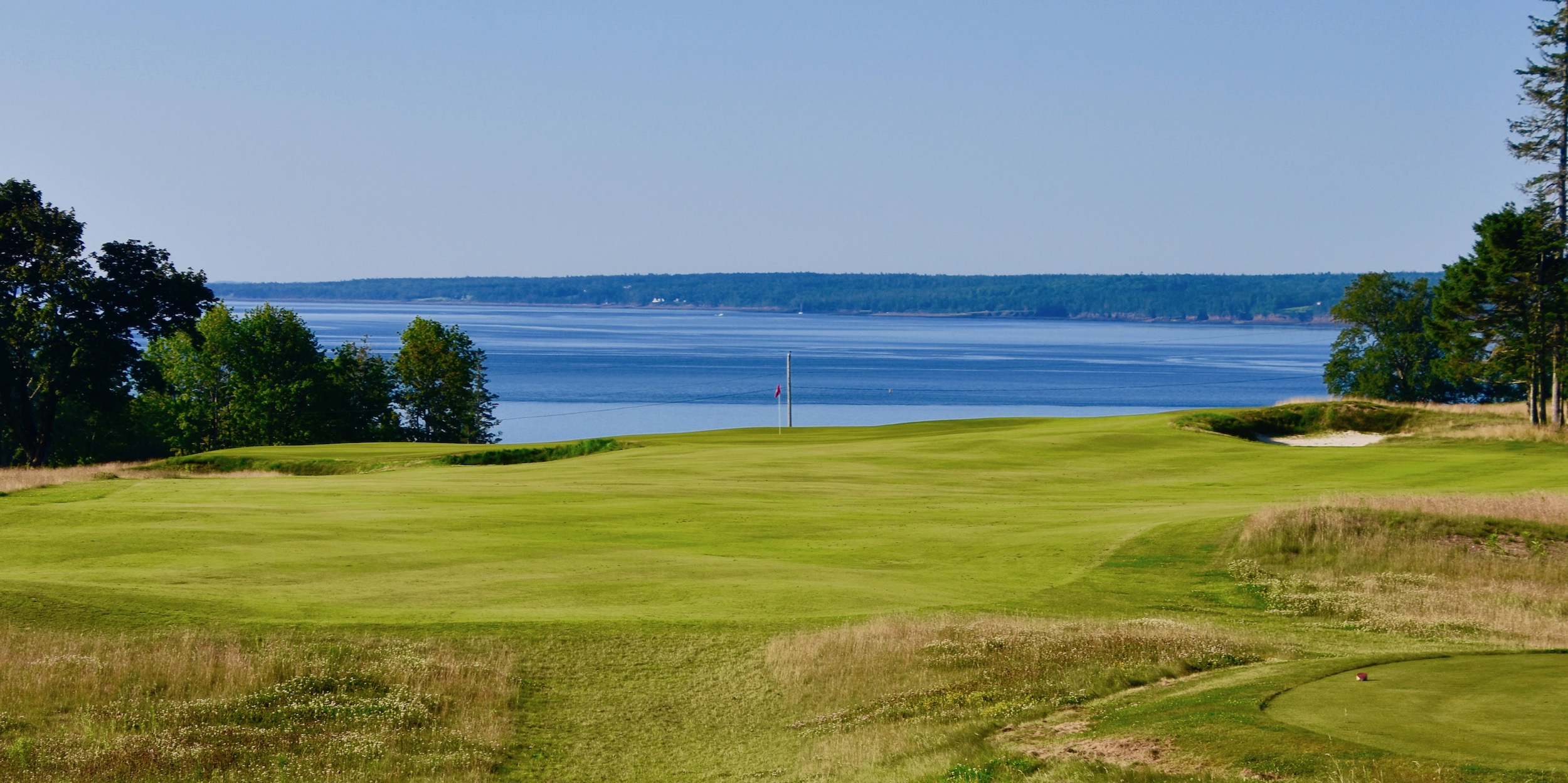
The back nine starts out with a very long par three that is the #2 handicap hole. However, it plays downhill and should be reachable for most golfers. The real problem is club selection. This is the first of several infinity greens on the Algonquin Golf Course. The backdrop of Passamaquoddy Bay is visually beautiful, but where the green ends is very difficult to determine the first time you play this hole.
Algonquin Golf Course #11 – 522 Yard Par Five
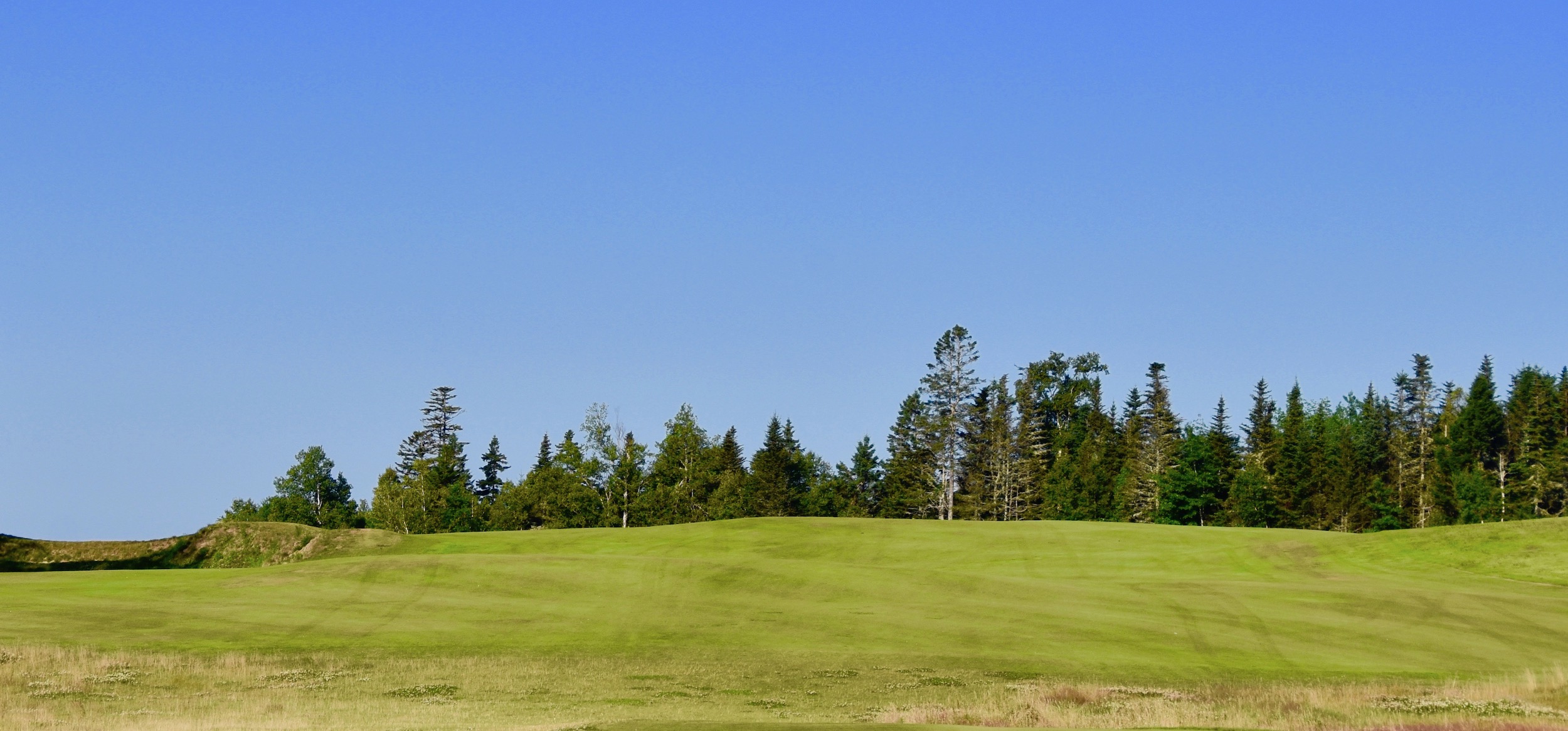
The back nine features three par threes, three par fives and only three par fours. This is actually a feature I really appreciated at the Algonquin Golf Course. Rod Whitman wasn’t stuck in the traditional mode of five par fours per nine, but rather went with what the terrain dictated.
The tee shot here is blind with a very generous landing area. Once you crest the hill you get this fantastic look down to Passamaquoddy Bay where a fishing boat happens to be passing by. On the other side of the bay is the Maine coast.
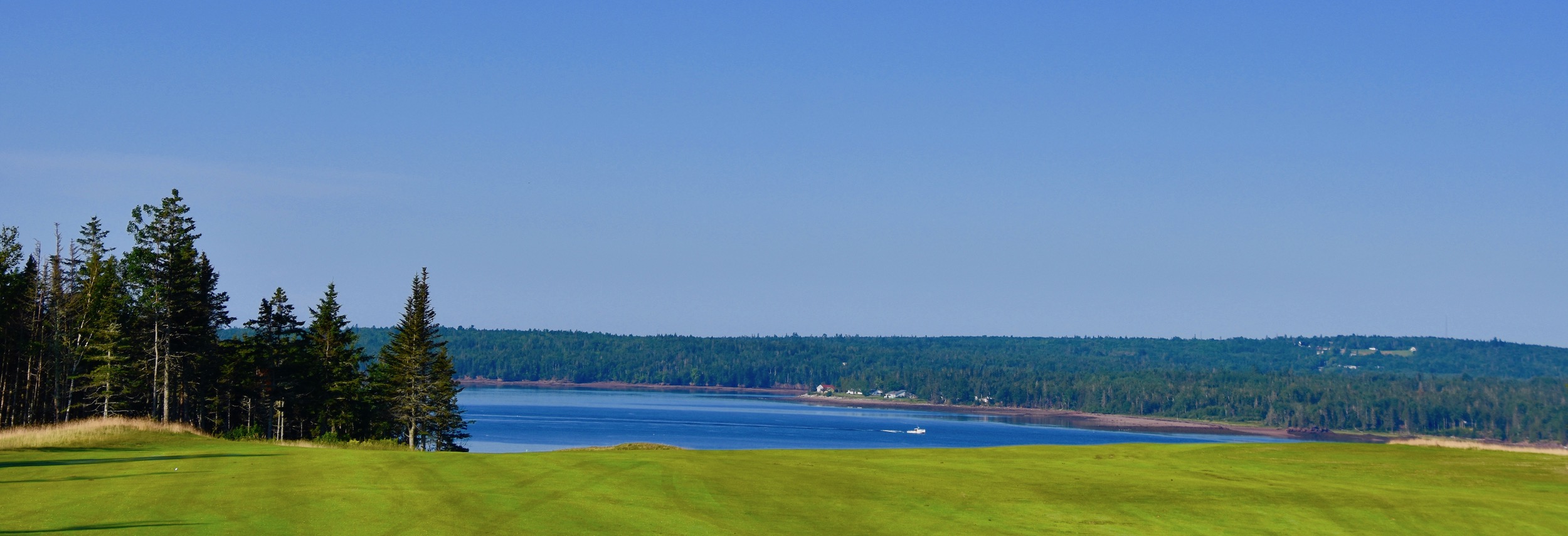
I was not able to reach this green in two despite playing severely downhill at the end. The result was an approach shot that is one of the nicest you are going to find anywhere. Another infinity green presents a bit of a quandary about going long, with the result that of course I came up short. The two bunkers should not be an issue from this position. Simply a fabulous par five, but there are even more breathtaking holes to come.
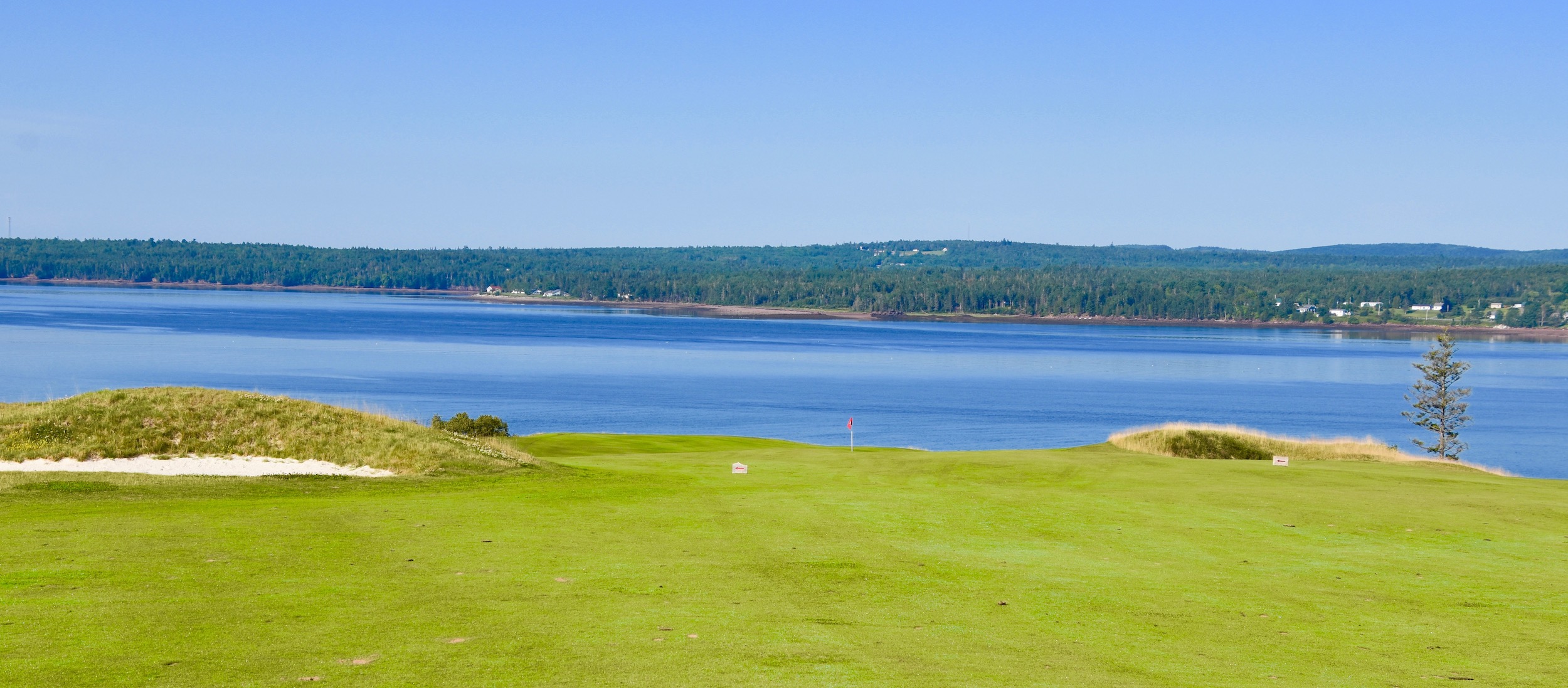
#12 – 132 Yard Par Three
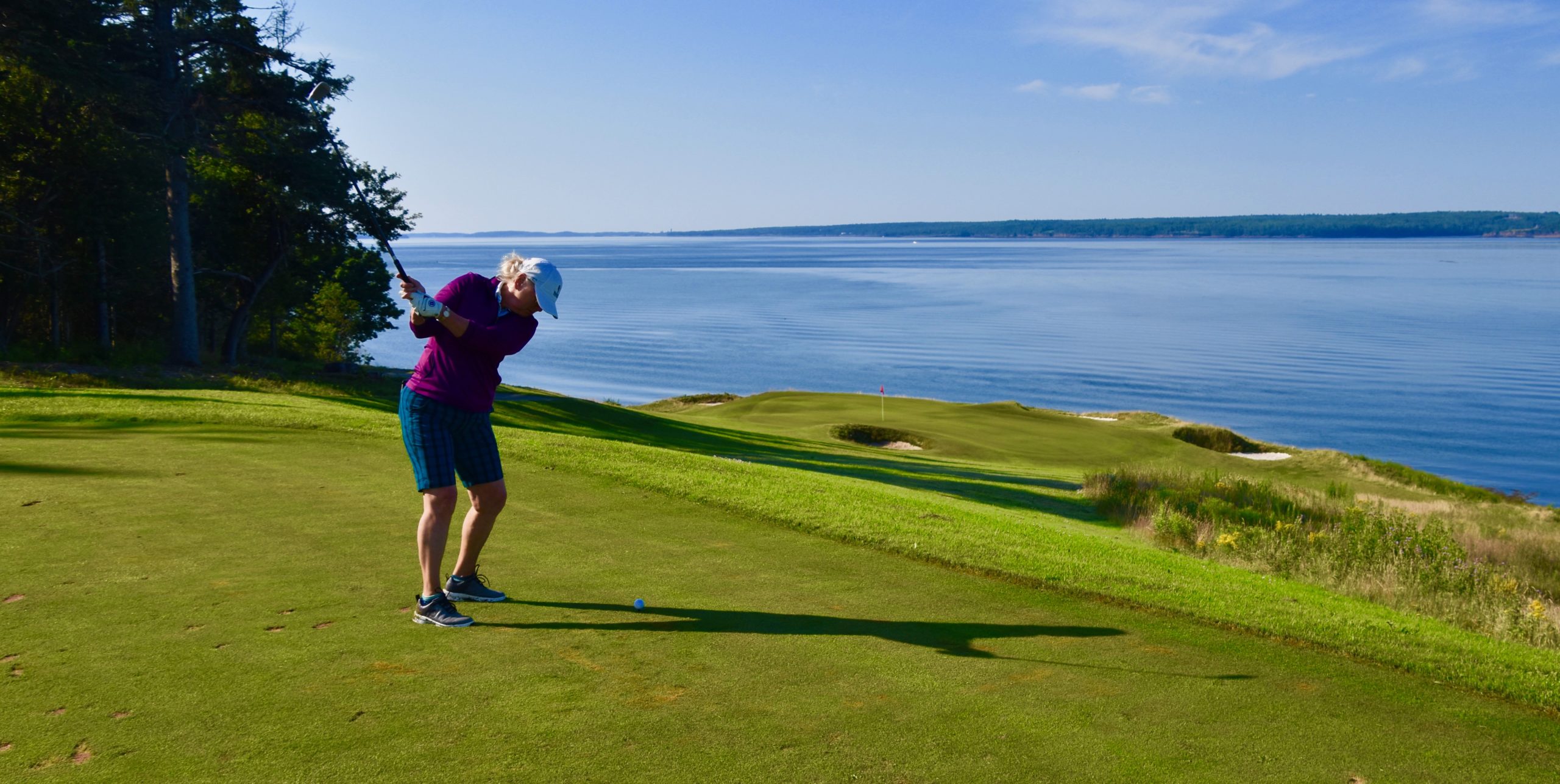
According to Zach Rodrigue, the Director of Golf, there isn’t one definitive signature hole on the Algonquin Golf Course and having played it, I have to agree. Certainly #12 and #13 would both qualify on almost any other course. This short par three looks amazing from the tee, but despite its short length, it is not easy. The green has almost no depth and with today’s pin placement, almost impossible to get at unless you can spin the ball which 99% of golfers cannot do. I can’t agree that it is the third easiest hole on the course. But really, who cares when you get to play it in conditions like today?
Algonqion Golf Course #13 – 414 Par Five
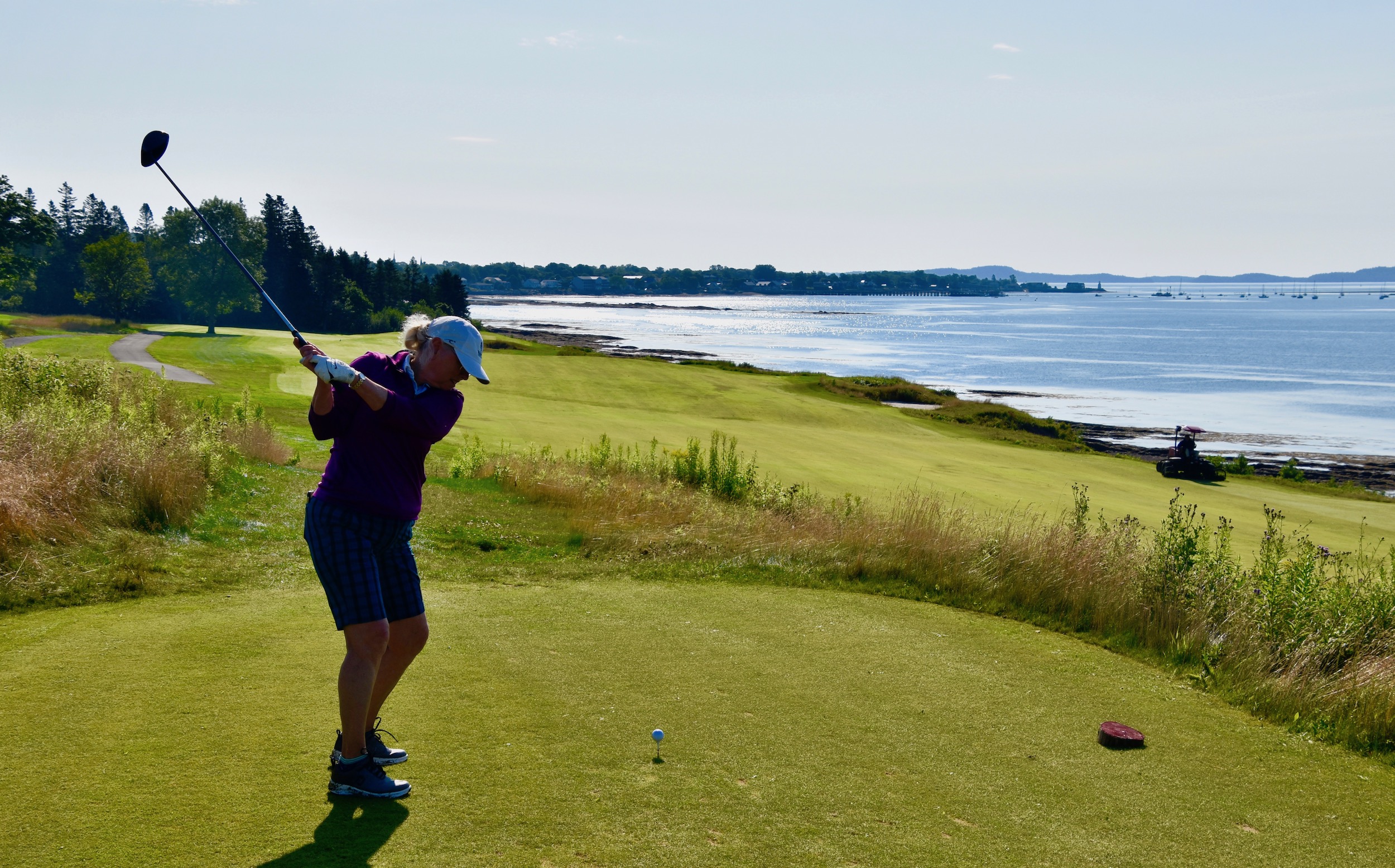
This ultra short par five reminded me very much of the third hole at Kingsbarns in Scotland which is also a par five with the ocean all down the right side. Both are simply stunning golf holes. Fortunately my right to left ball flight made it easy to avoid the water here and have this very short approach for an easy par. The hardest thing about this hole is not being distracted by the incredible views which now include the St. Andrews waterfront.
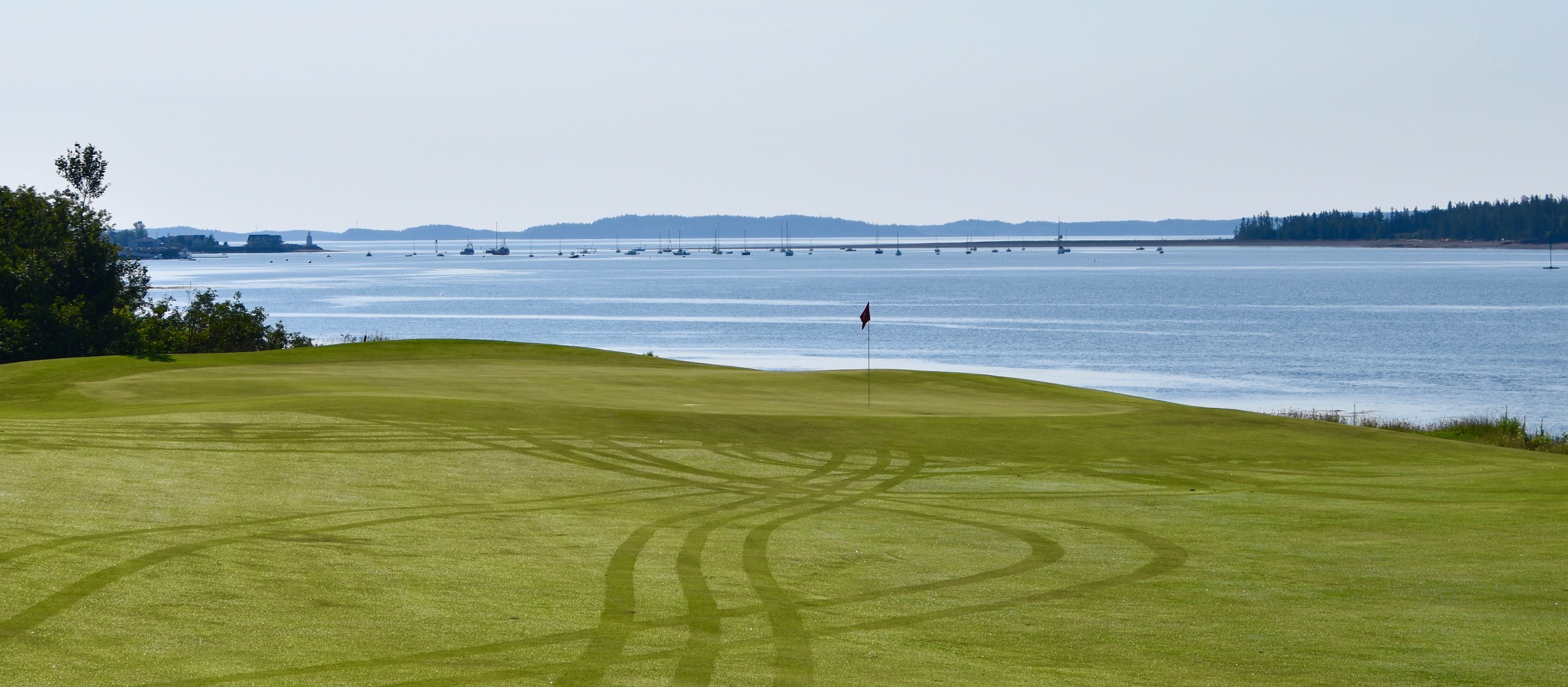
So that’s the first four holes on the back nine that Jason and Robert and now Dale all were blown away by. Will the last five be a let down? Let’s find out.
#14 – 146 Yard Par Three
Although you move away from holes directly fronting the ocean for the rest of the Algonquin Golf Course, you can still see the ocean from every hole on the back. This third par three in five holes seemed to play much longer than its stated yardage. It also presented more problems off the tee than any par three except perhaps for #12.
Algonquin Golf Course # 15 – 385 Yard Par Four
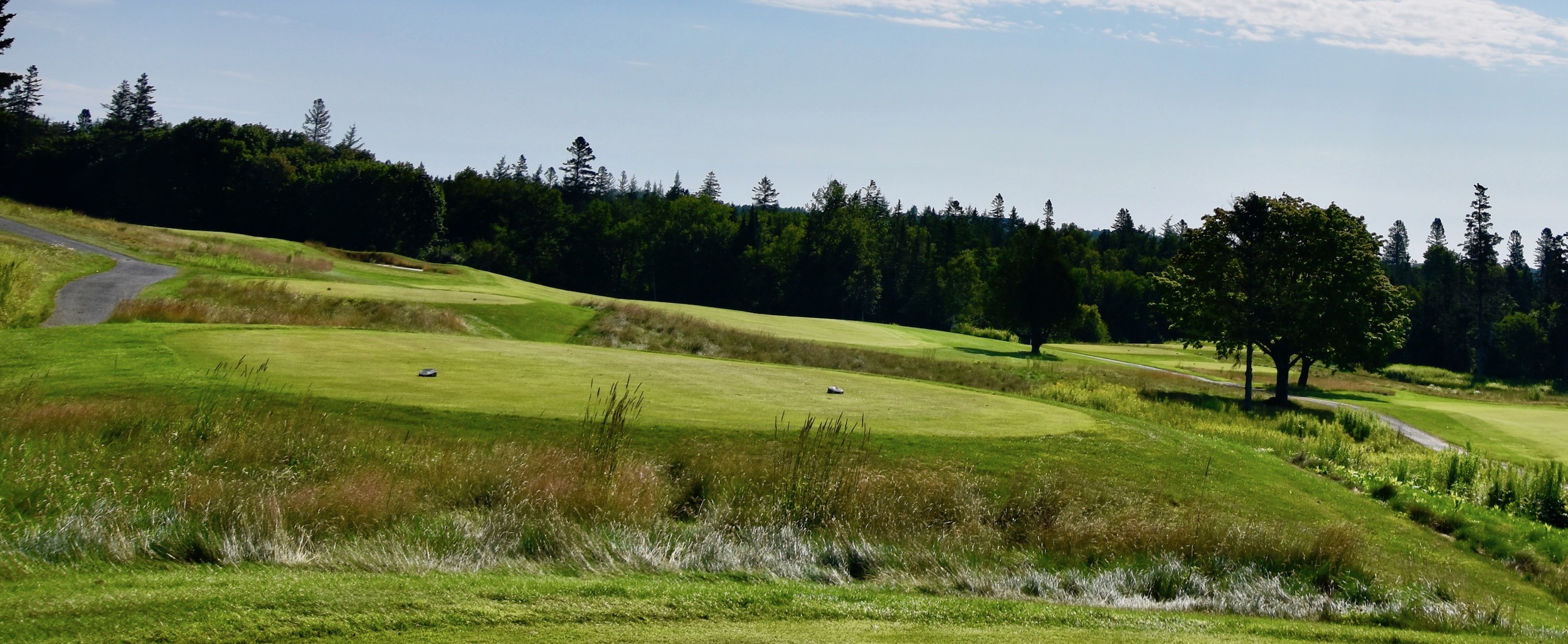
I haven’t mentioned the bunkers yet, mainly because I largely avoided them today, whether by luck or skill I can’t say. However, there are a number on this course that are monsters, far closer to what you might find on a links course than in a typical North American course. To add to the European look the fescue has been allowed to grow around the edge of the bunkers. No. 15 has good examples of both the fairway and green side bunkers.
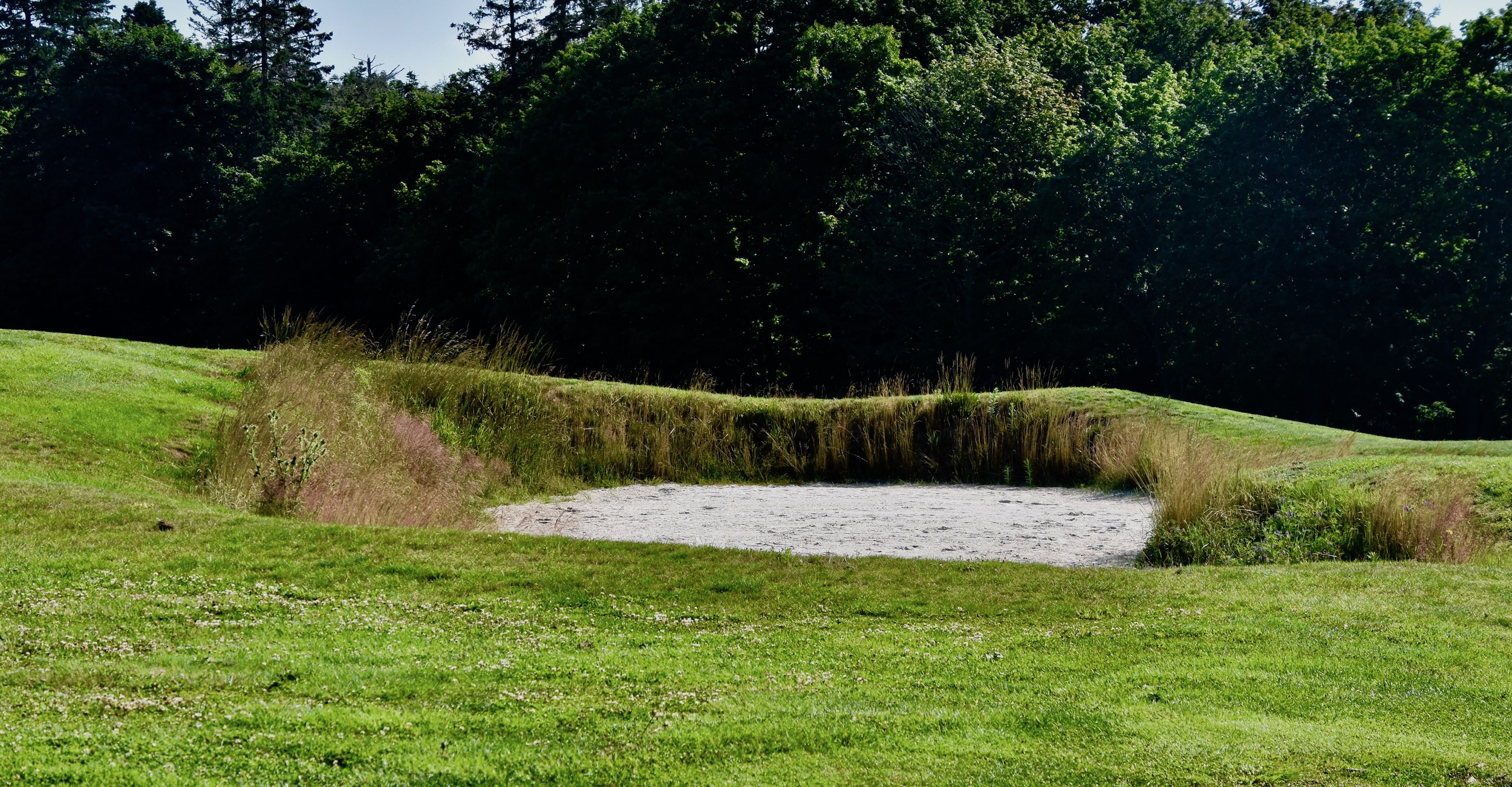
The course was still observing the Covid protocols so there were no rakes making it difficult to make a fair assessment of the playability of the sand in them.
The small building you see in the background is actually the oldest clubhouse in Canada dating from the 1894 nine hole course on the grounds of the hotel. It definitely has a similarity to the St. Andrews blockhouse.
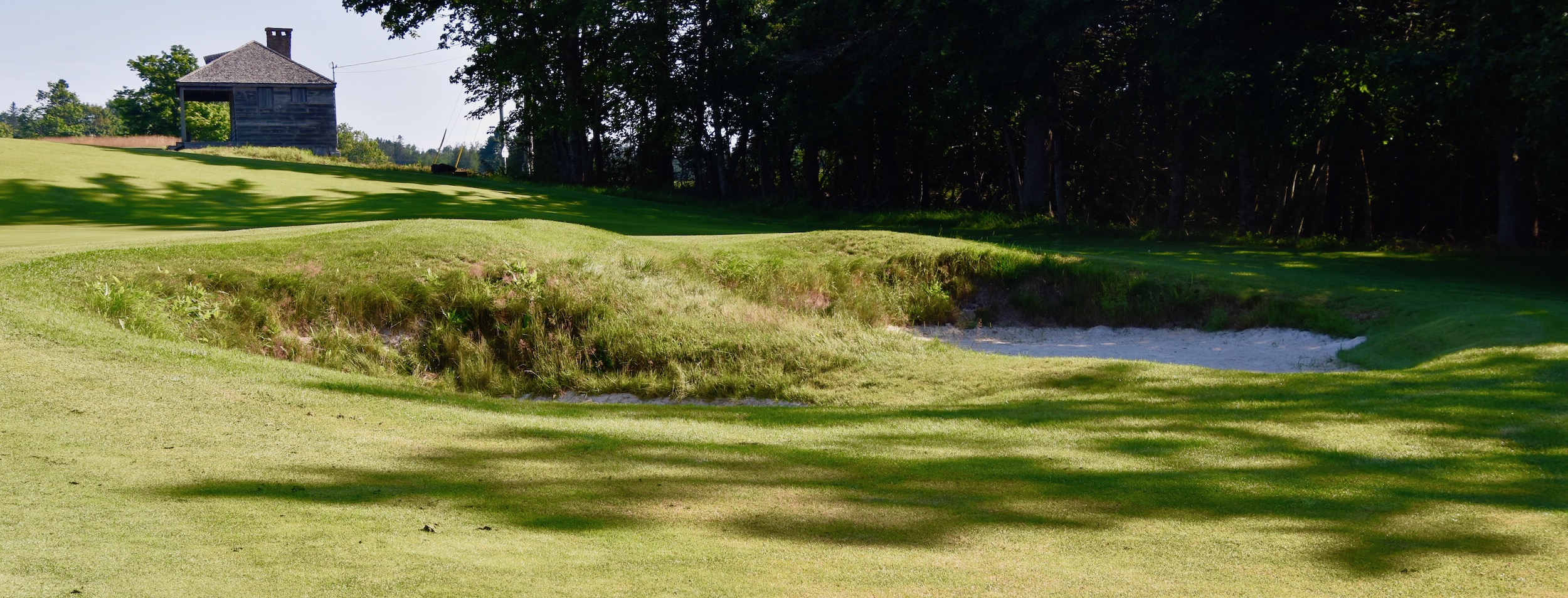
#16 – 377 Yard Par Four
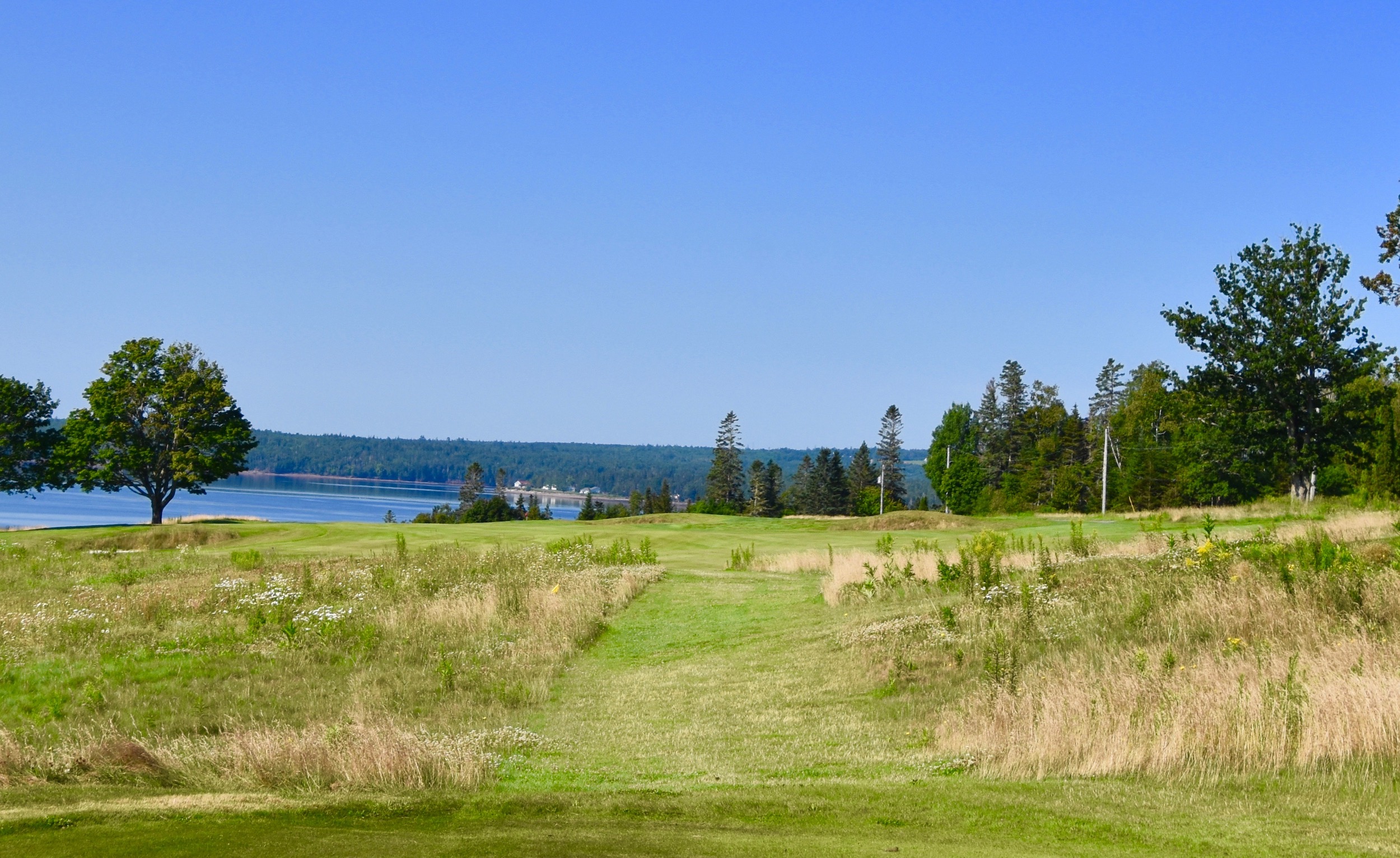
The ocean is very much in view if not in play on No. 16 at the Algonquin Golf Course, another very strong par four with yet one more infinity green backed by awesome views.
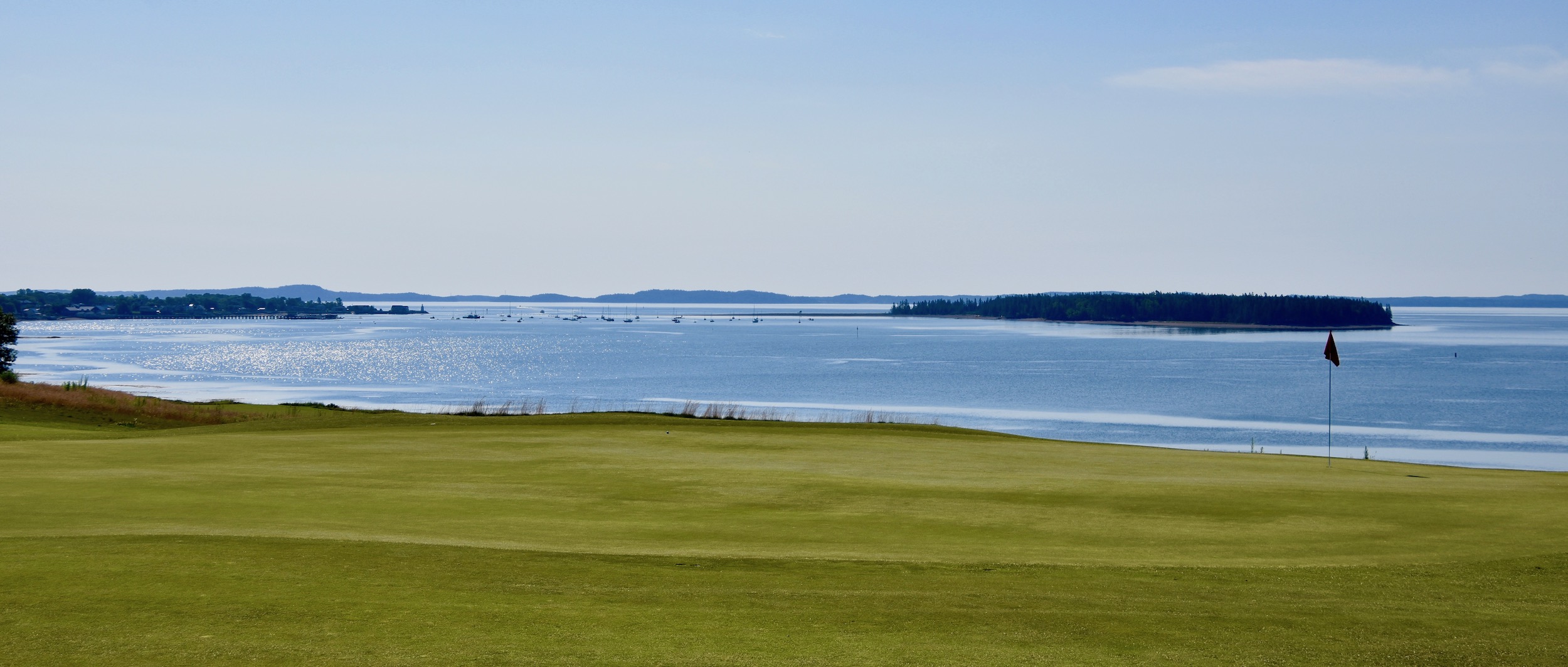
Algonquin Golf Course #17 – 469 Yard Par Five
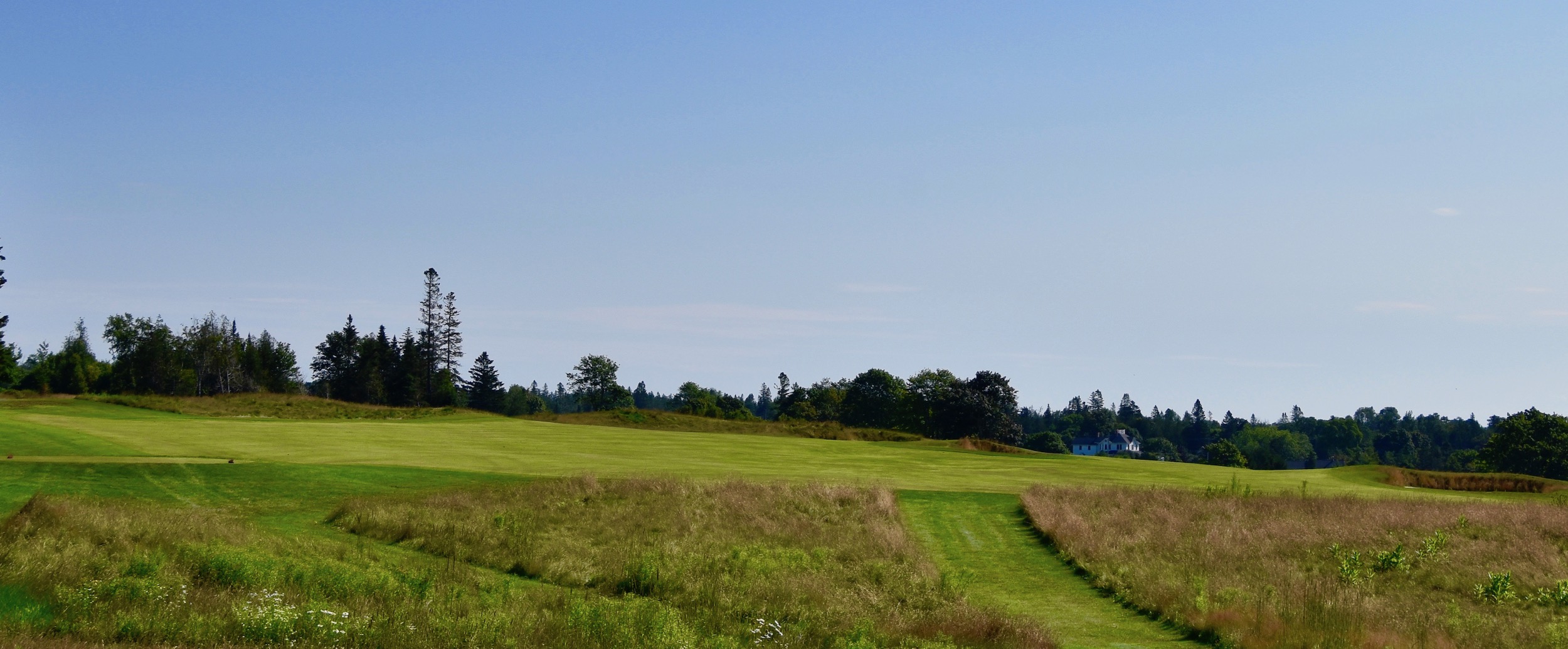
The last of the blind tee shots leads once more to a wonderful approach shot to a well protected green. This one of a number of holes at Algonquin Golf Course that you could use bump and run rather than pitch. You can see a couple of houses on this hole which is not the norm. Virtually every hole on the back and most on the front are stand alone holes with very few adjoining fairways. This definitely adds to the enjoyment of playing here.
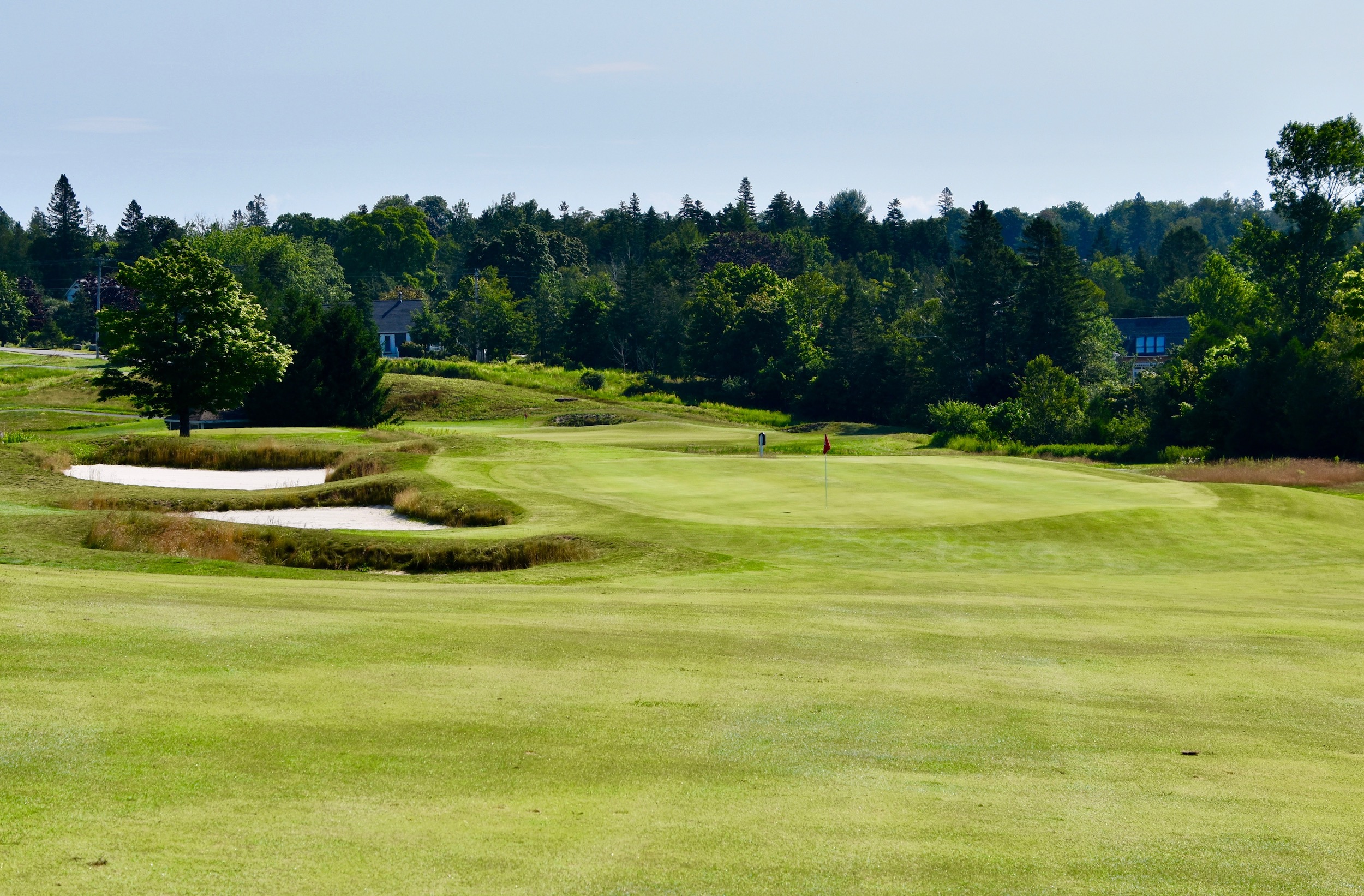
No. 18 – 309 Yard Par Four
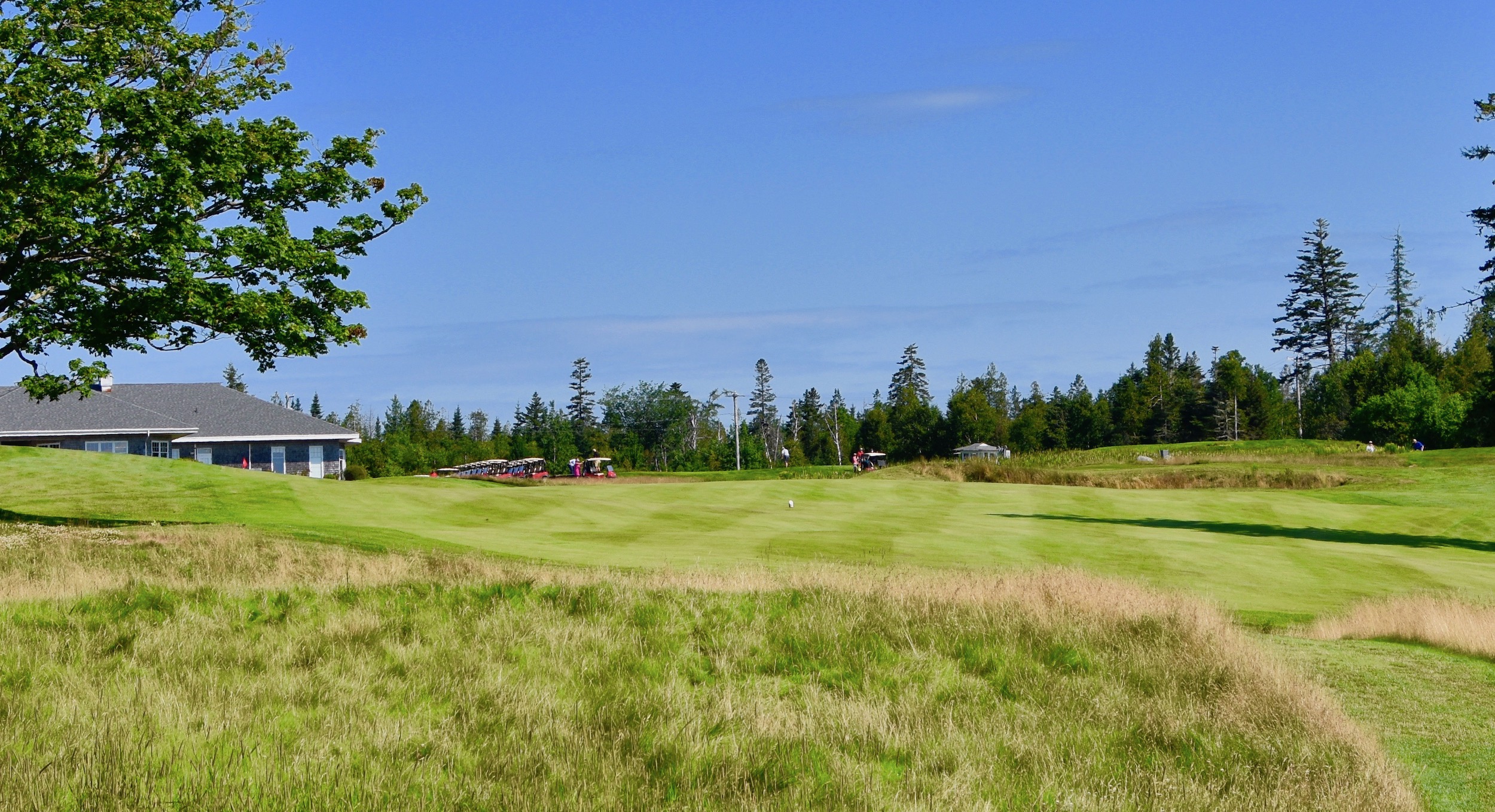
I have to confess that I found No. 18 the weakest hole on the back, a rather straightforward drive uphill followed by a not too difficult second shot. I guess the good news is that in all likelihood you’ll have maybe the best chance of the round for a birdie.
With no one in front of us we finished in about three hours. It was one of the most enjoyable rounds of golf I’ve played in a long time, but there’s more to come.
Smokehouse BBQ
Since we started so early we had only had coffee and stopped in the Algonquin Golf Course restaurant, the Smokehouse BBQ which has great ocean views from its patio. It also has what I think is the best breakfast sandwich I’ve had in years – the early birdie.
Here are two versions – mine on a bagel and Alison’s on brioche. There is more bacon in one than five McMuffins and the eggs were cooked perfectly.
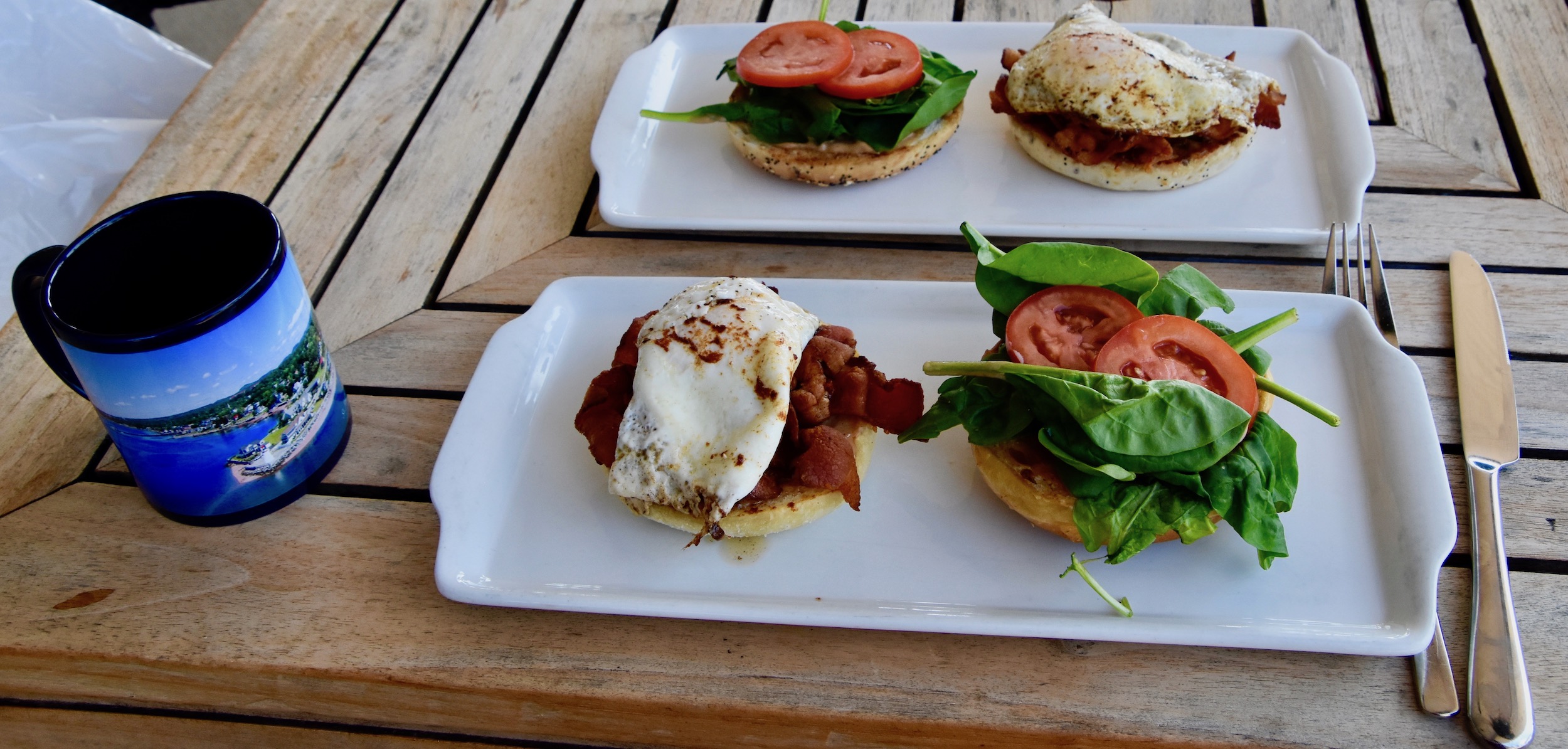
The smoker was creating a great aroma that wafted through the patio. We checked out the dinner menu and decided to return that night, which we did. This time it was brisket and ribs with great fixin’s. Those pickled veggies were incredible.
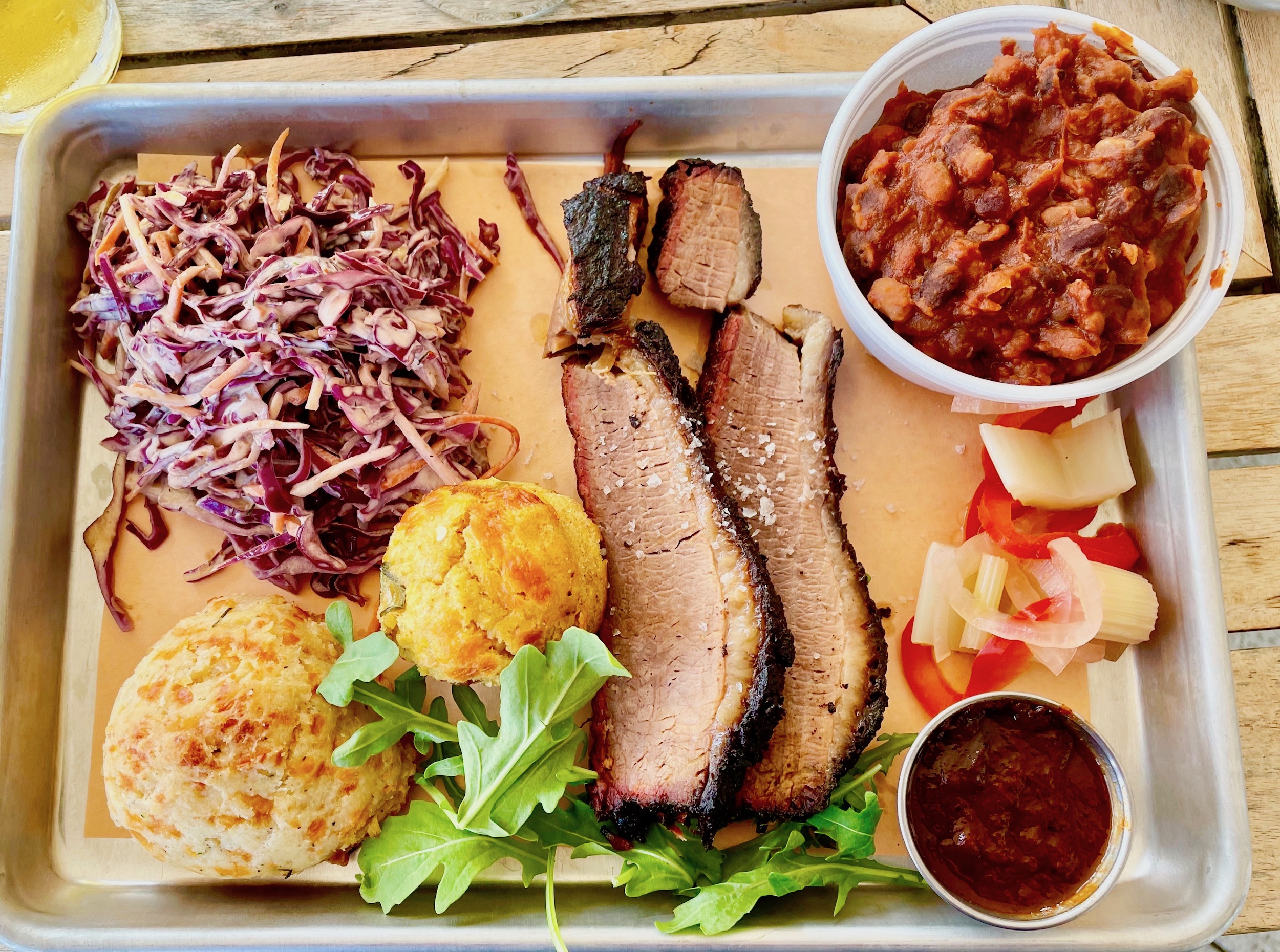
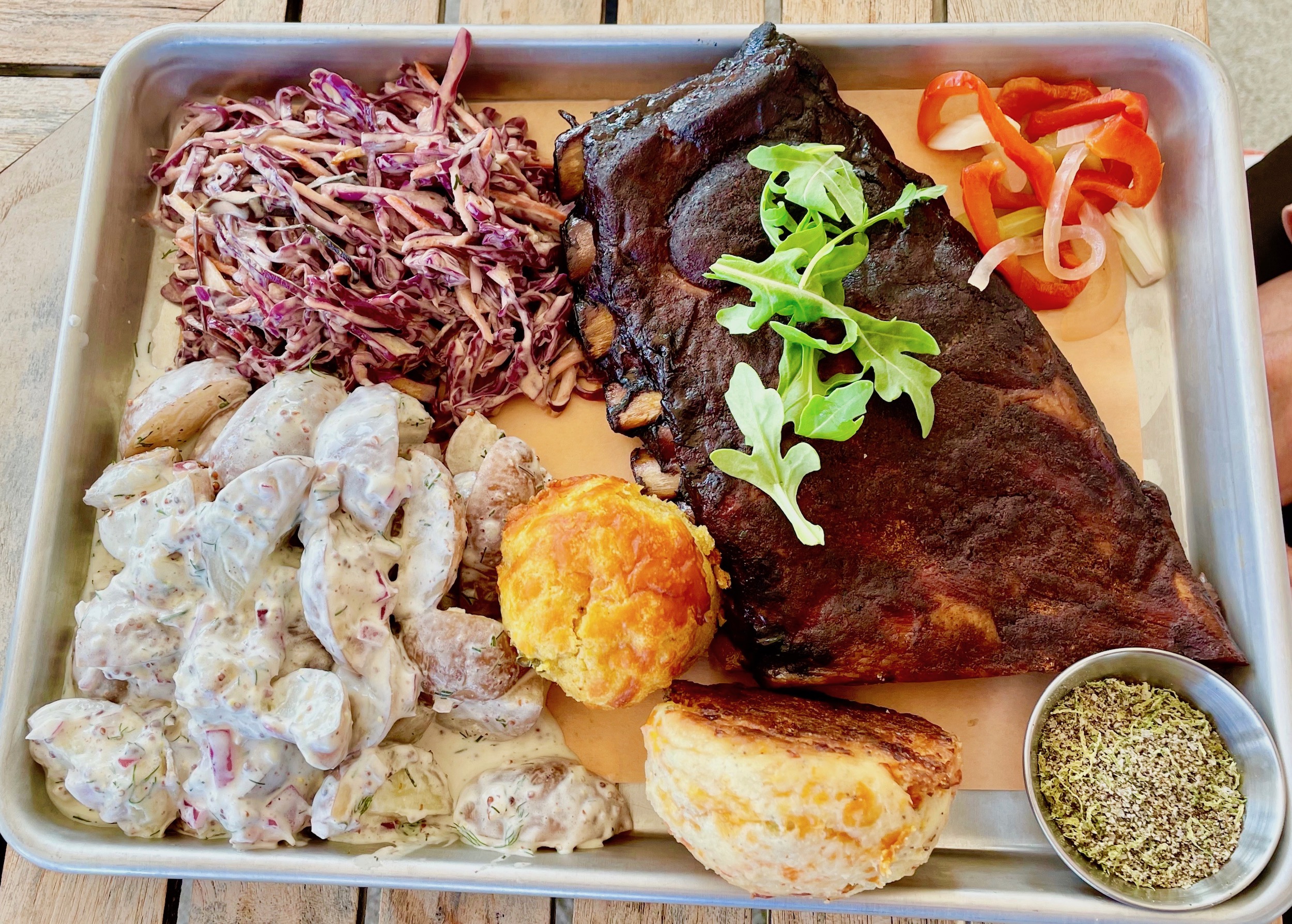
Before leaving St. Andrews the next morning we returned again for breakfast and then in the afternoon had a picnic lunch at Carleton Martello Tower in Saint John of what was left from the night before. So technically we ate four meals in a row from the Smokehouse BBQ. I guess that tells you all you need to know about how much we liked the food they serve at the Algonquin Golf Course.
Although it took four tries to play the course, I’m glad we got to do it in probably the best conditions possible. We’ll be back.
Now that the golf’s done, Alison and I have a chance to explore St. Andrews on foot and visit beautiful Kingsbrae Garden. Please join us.

